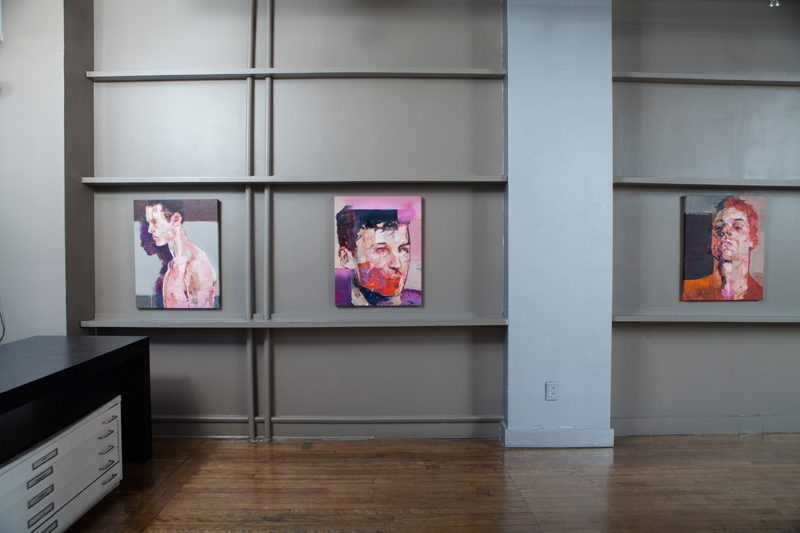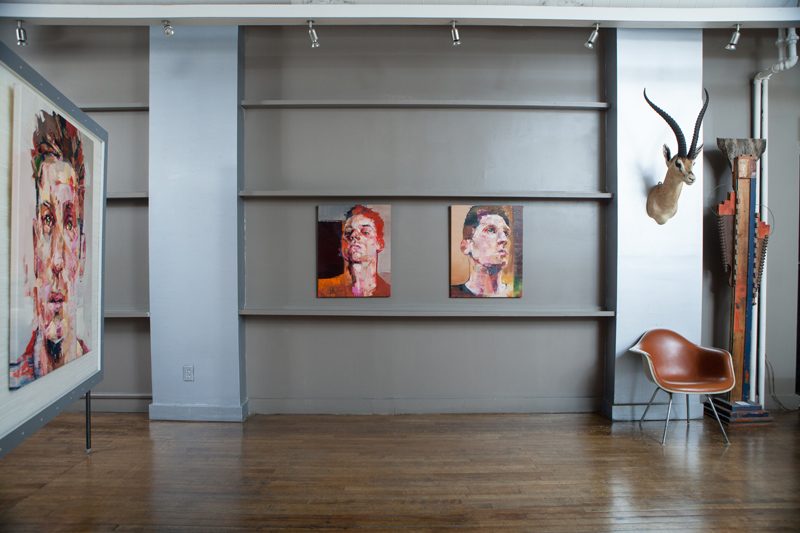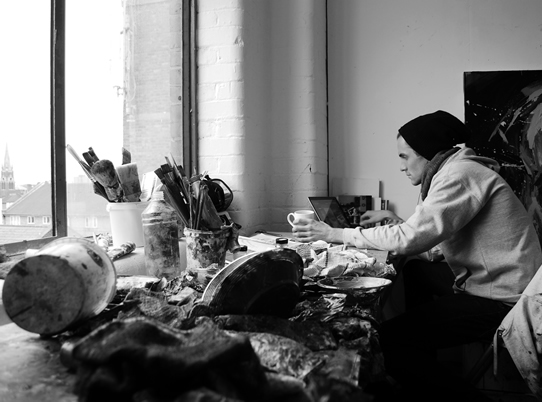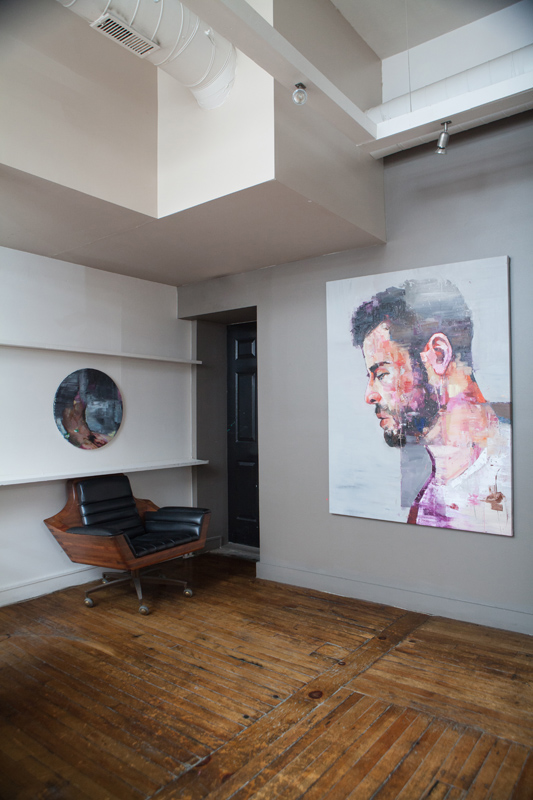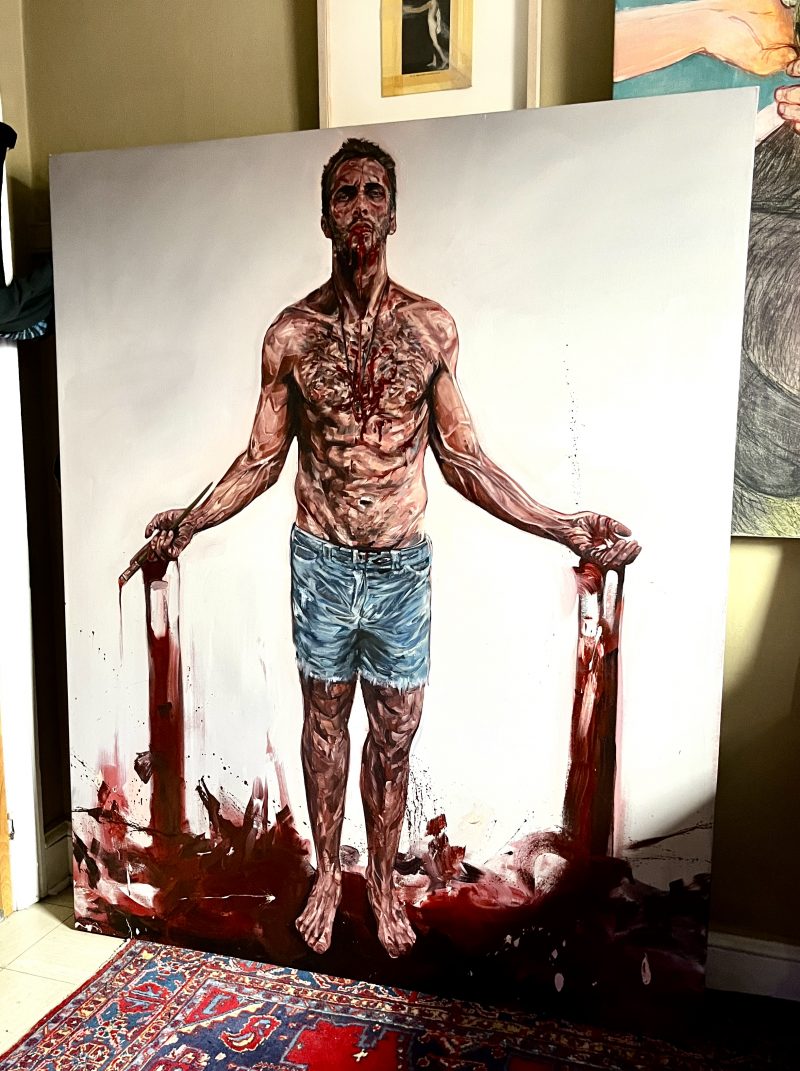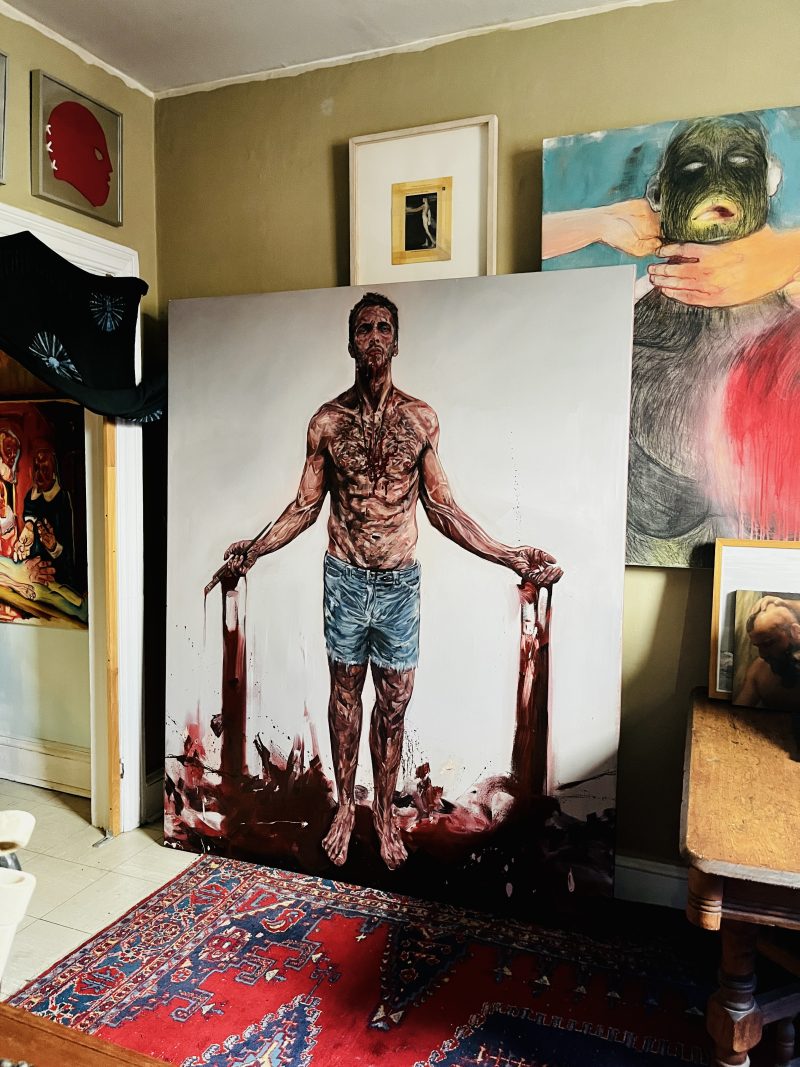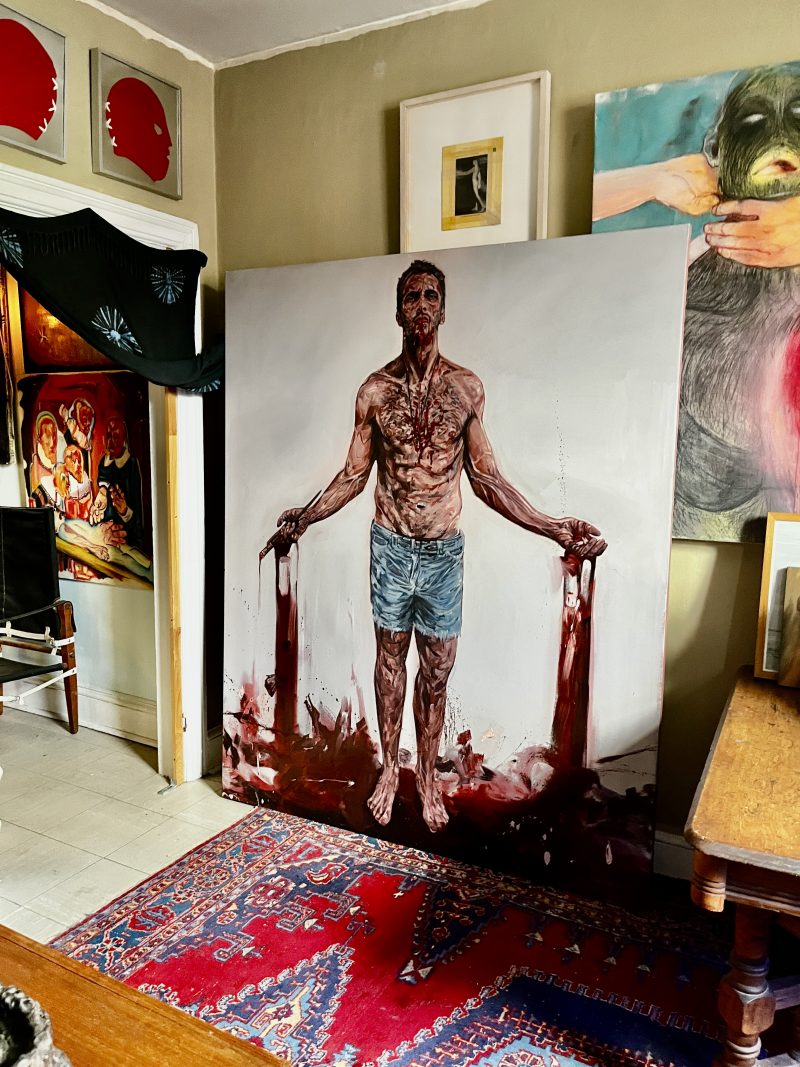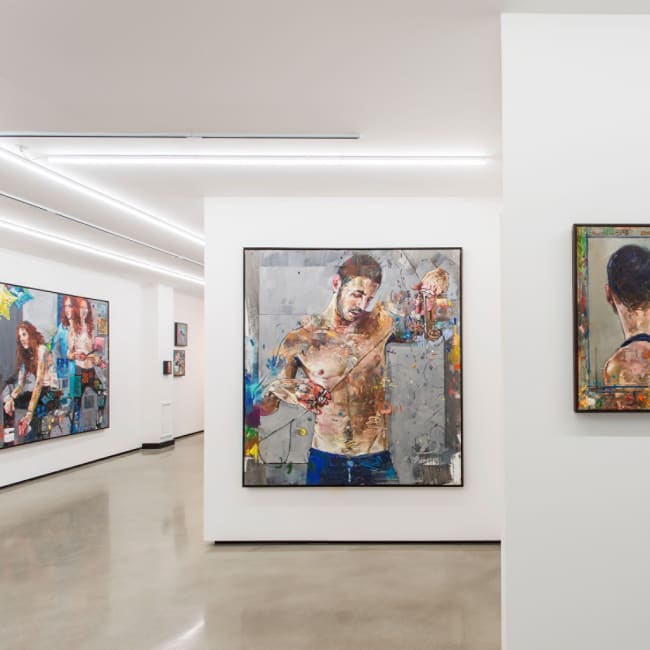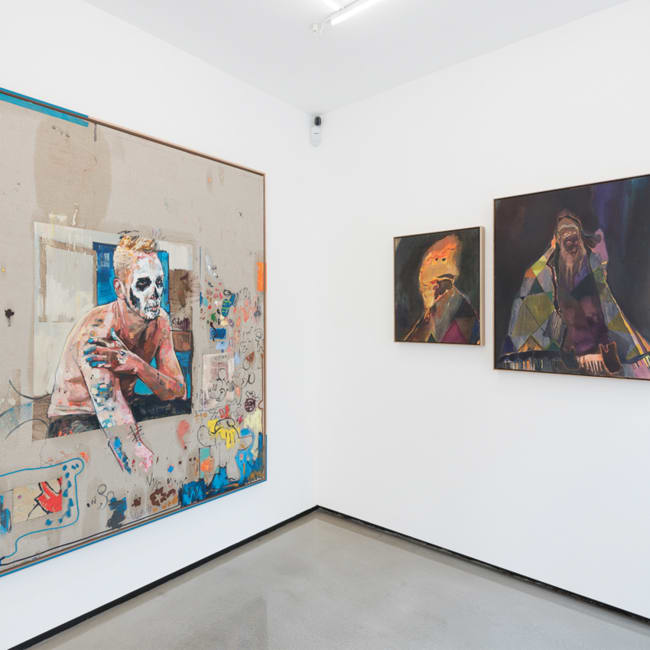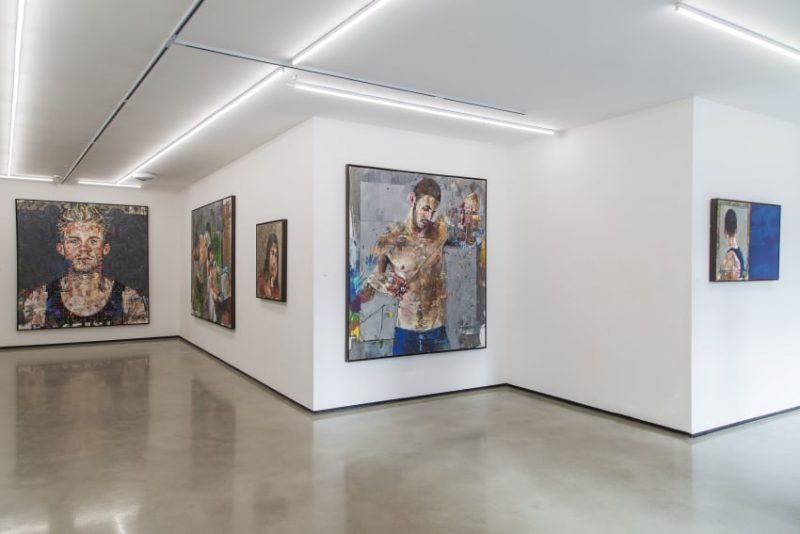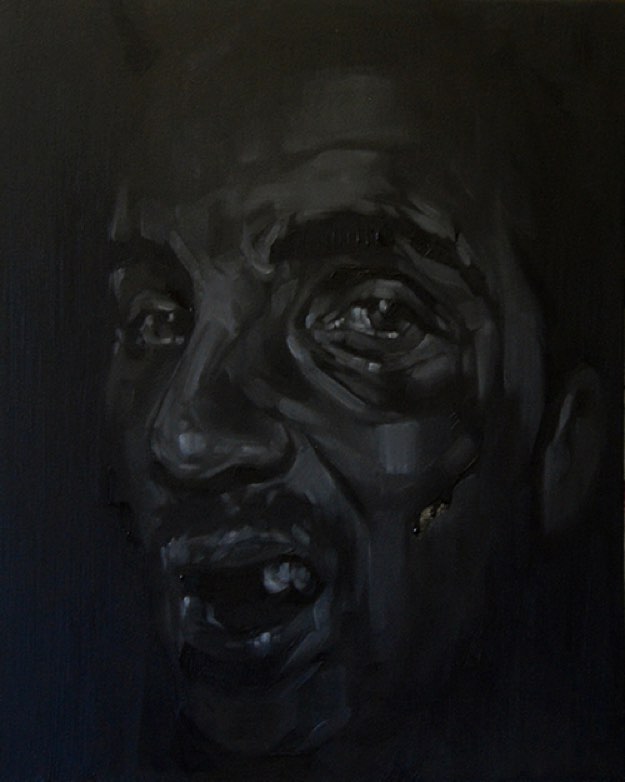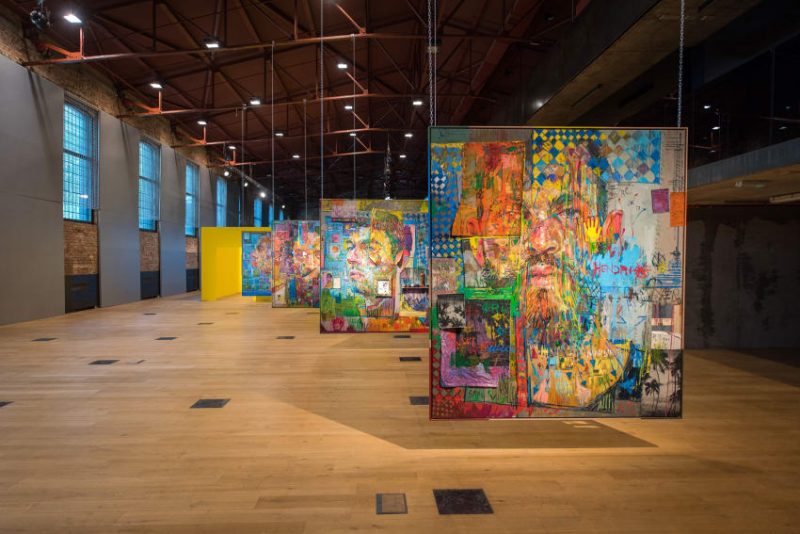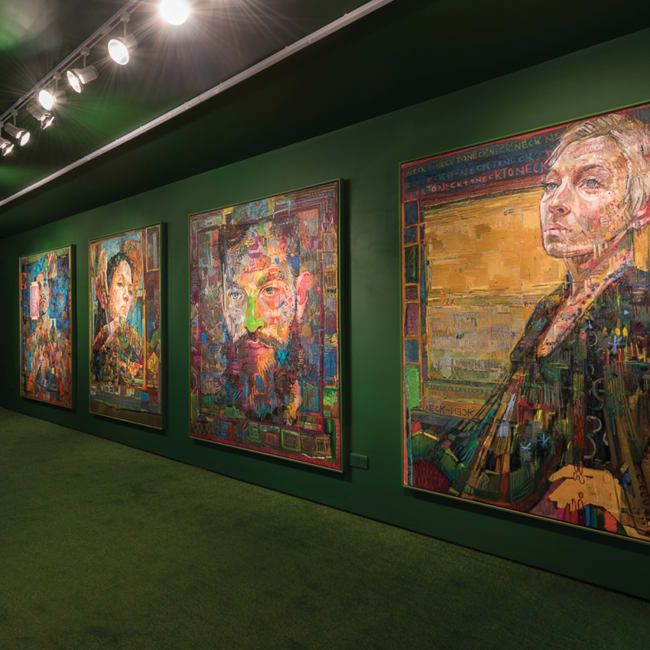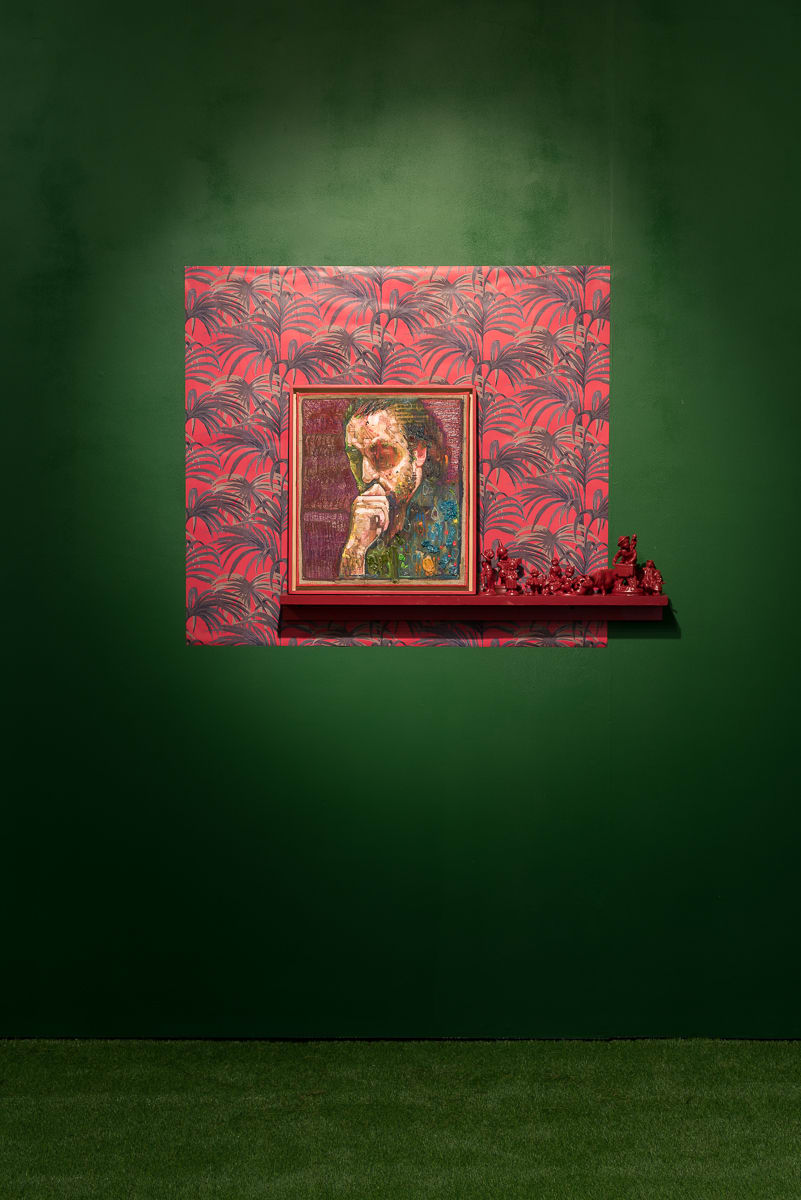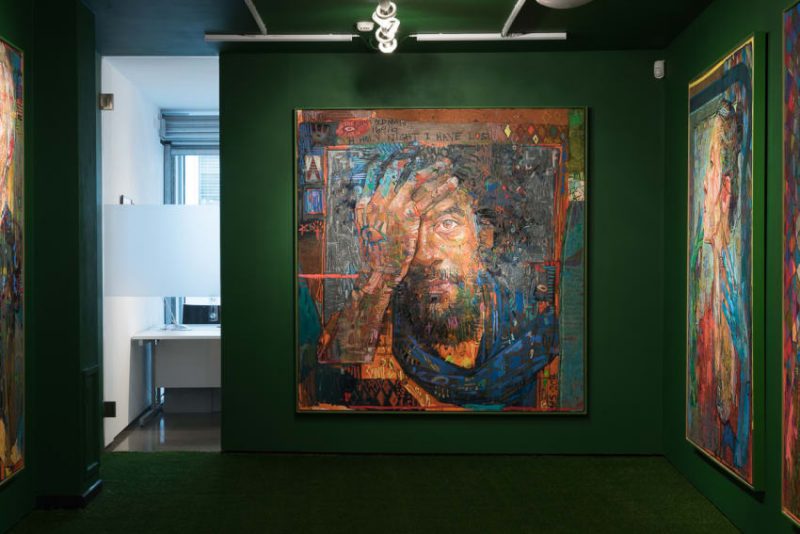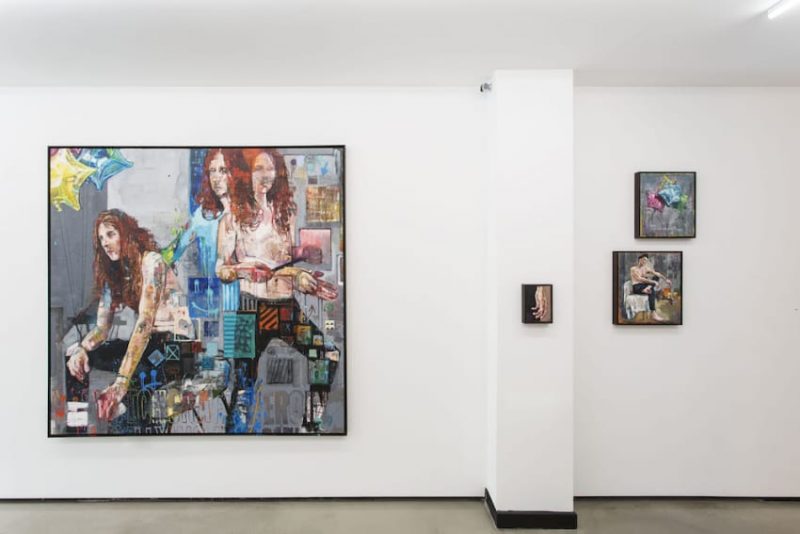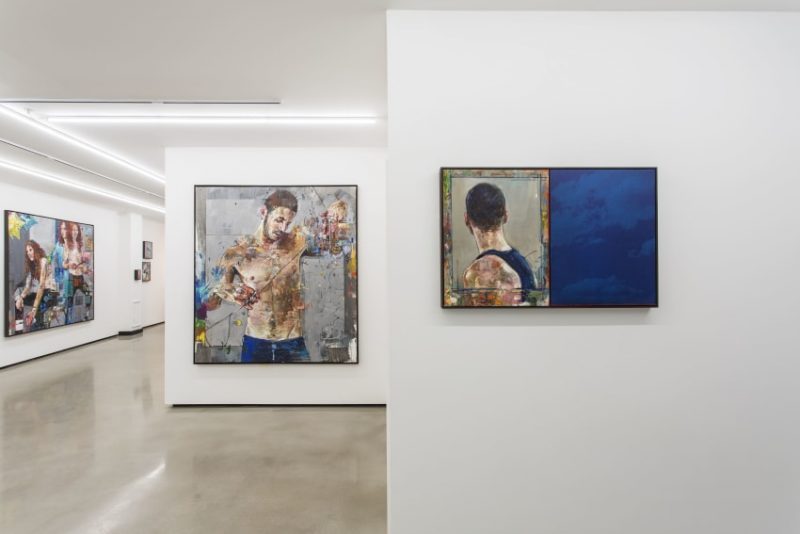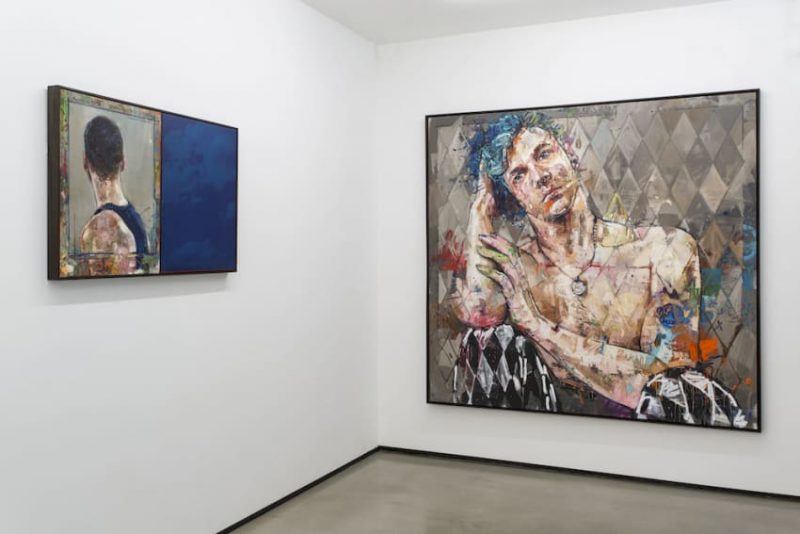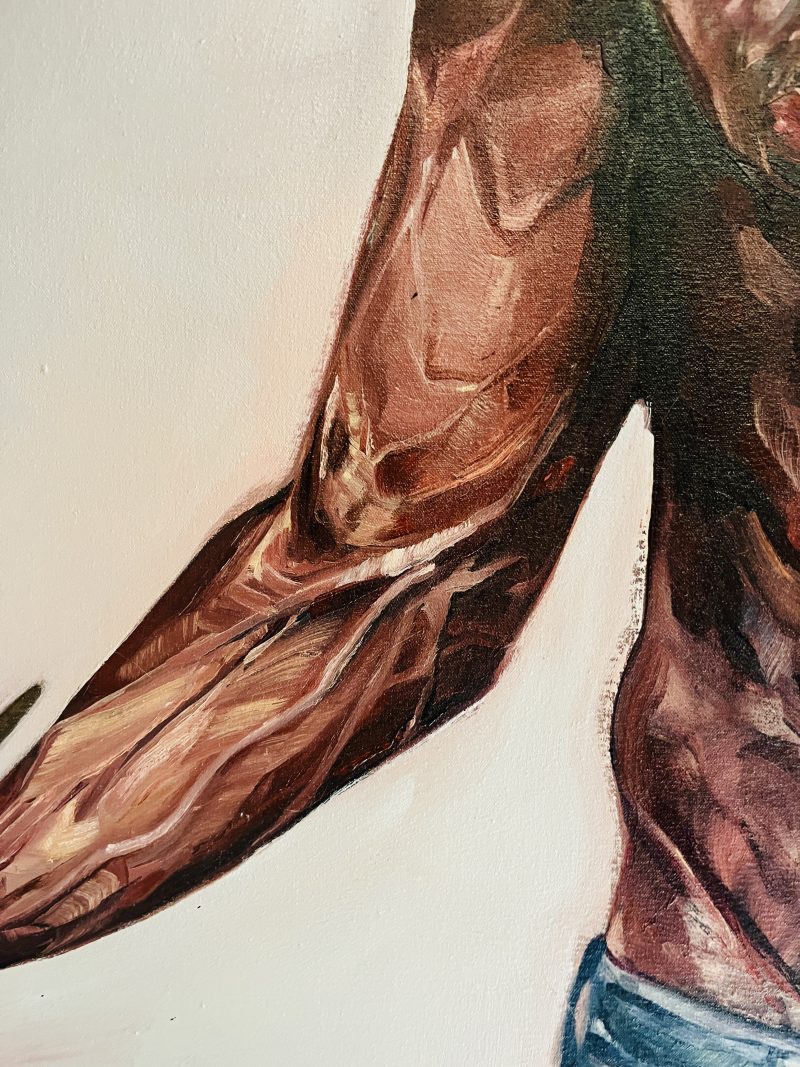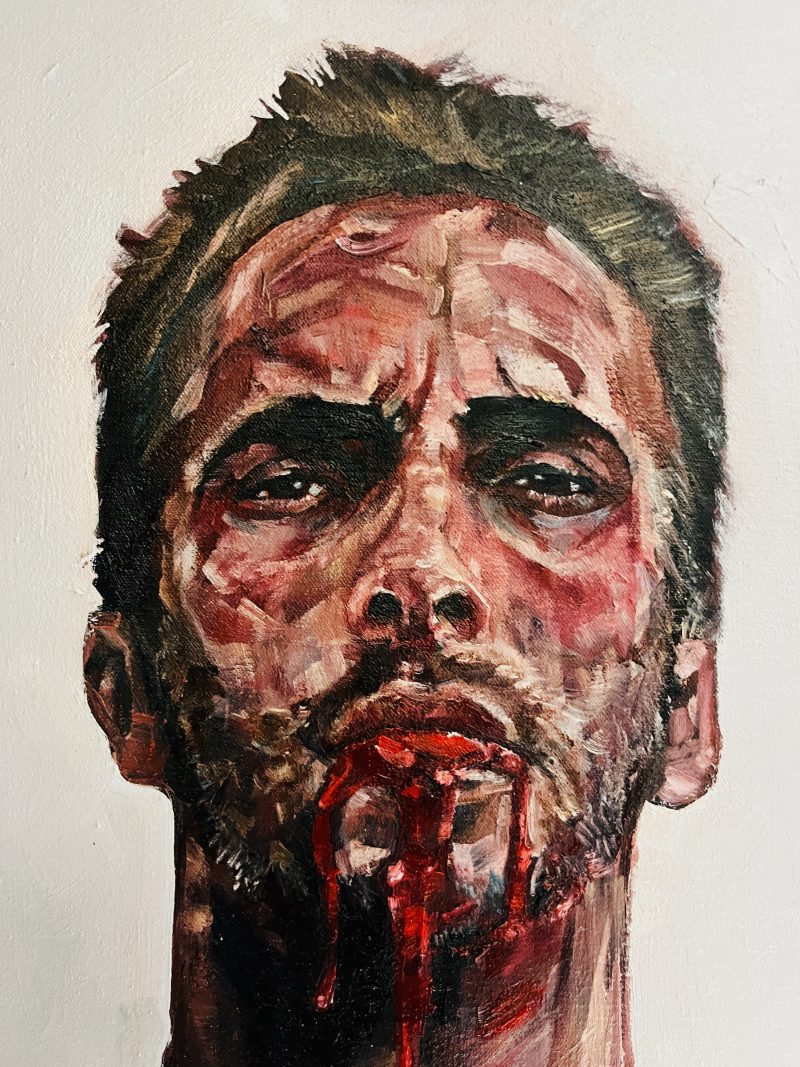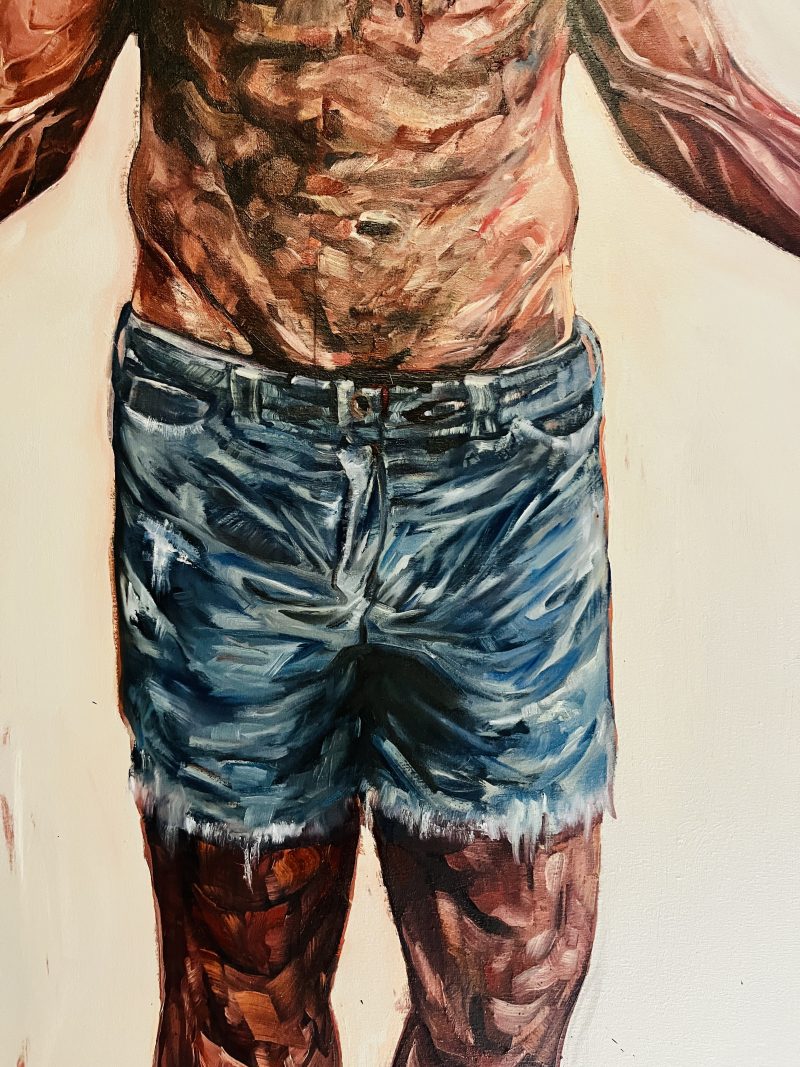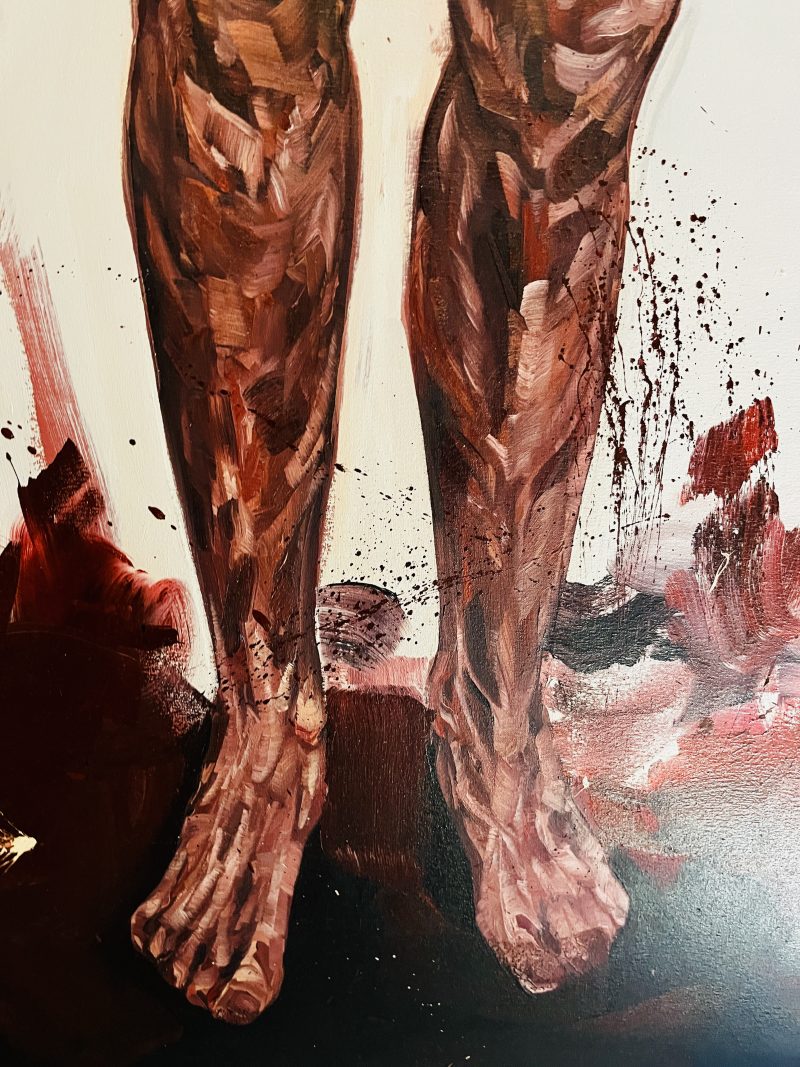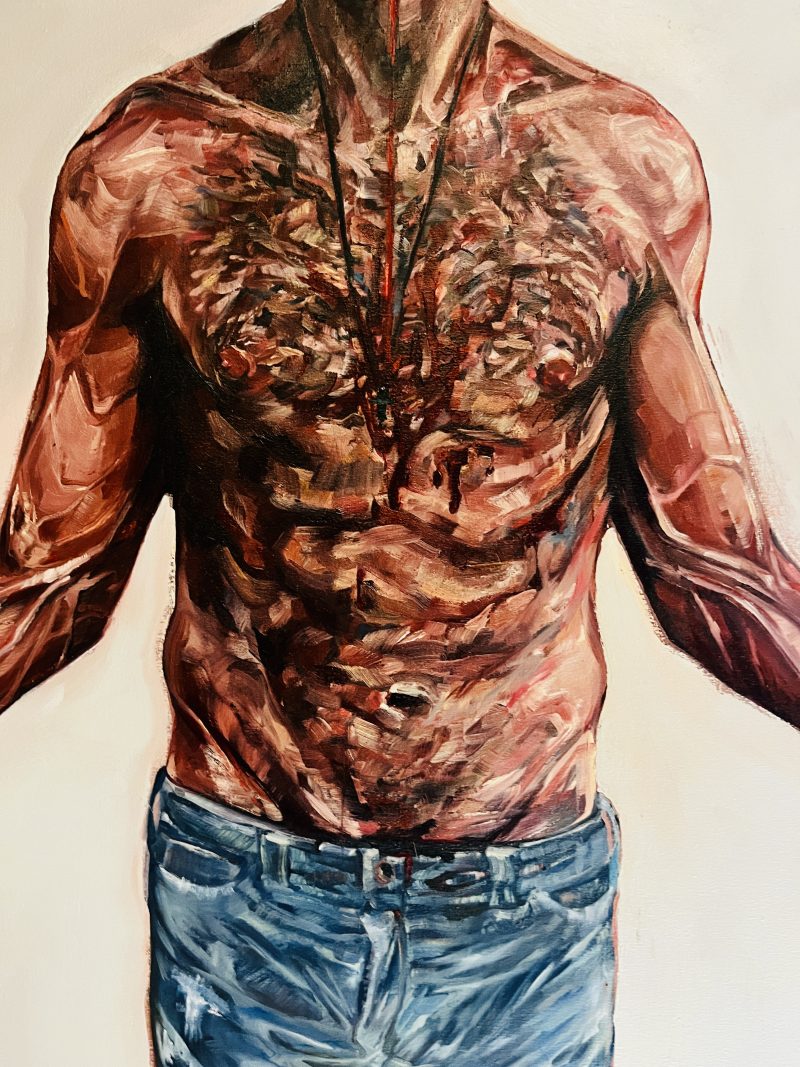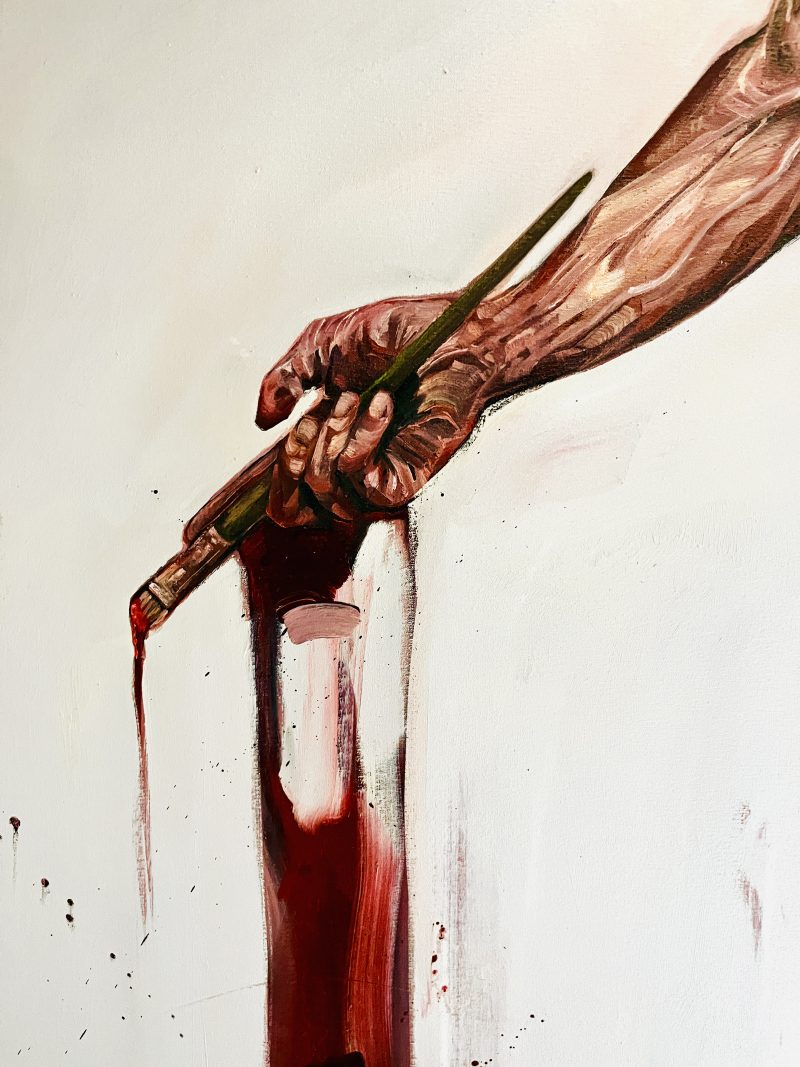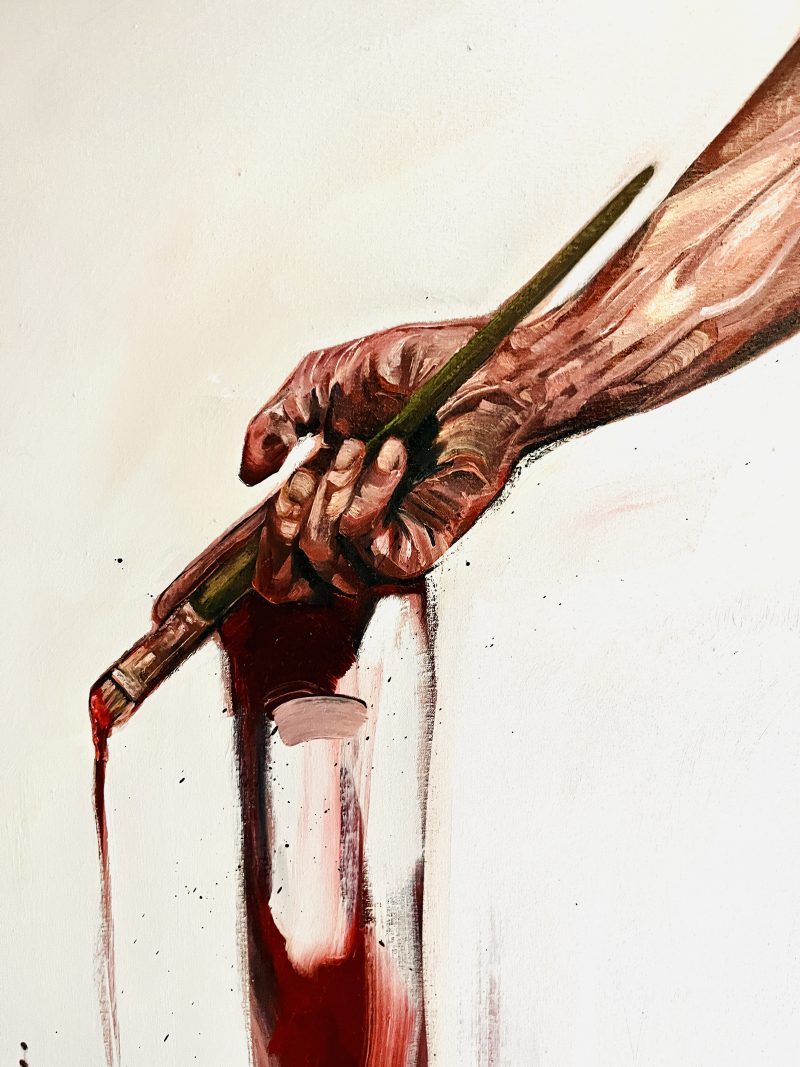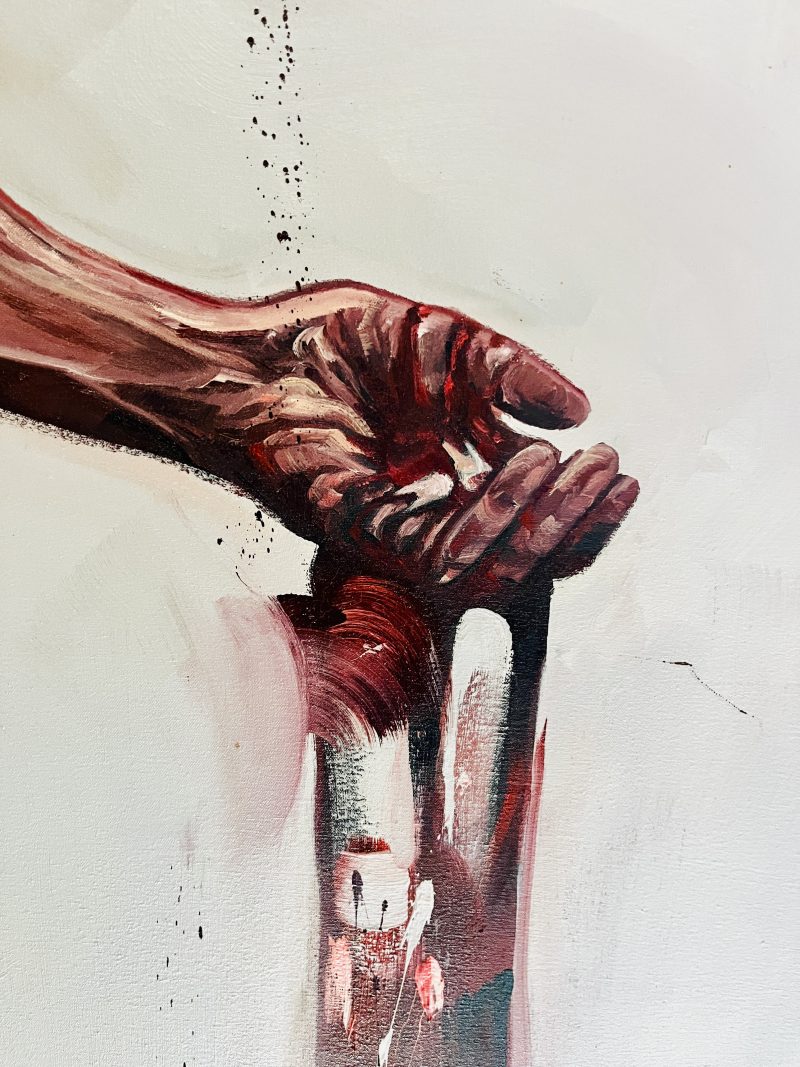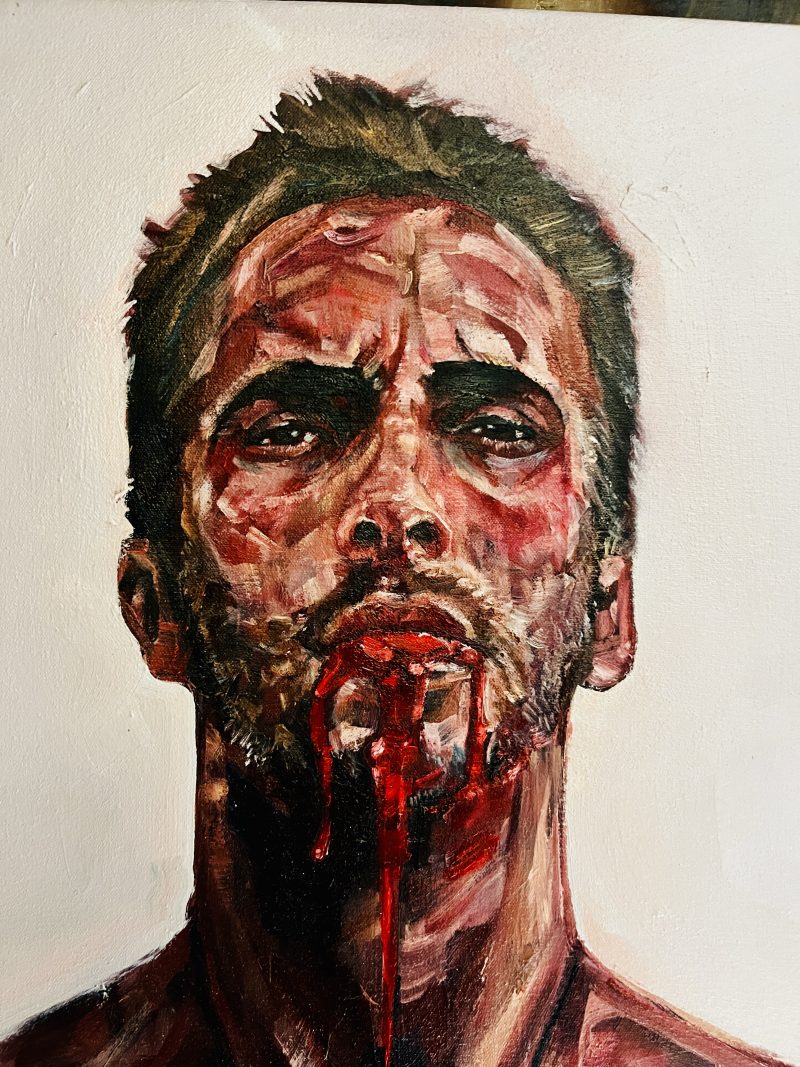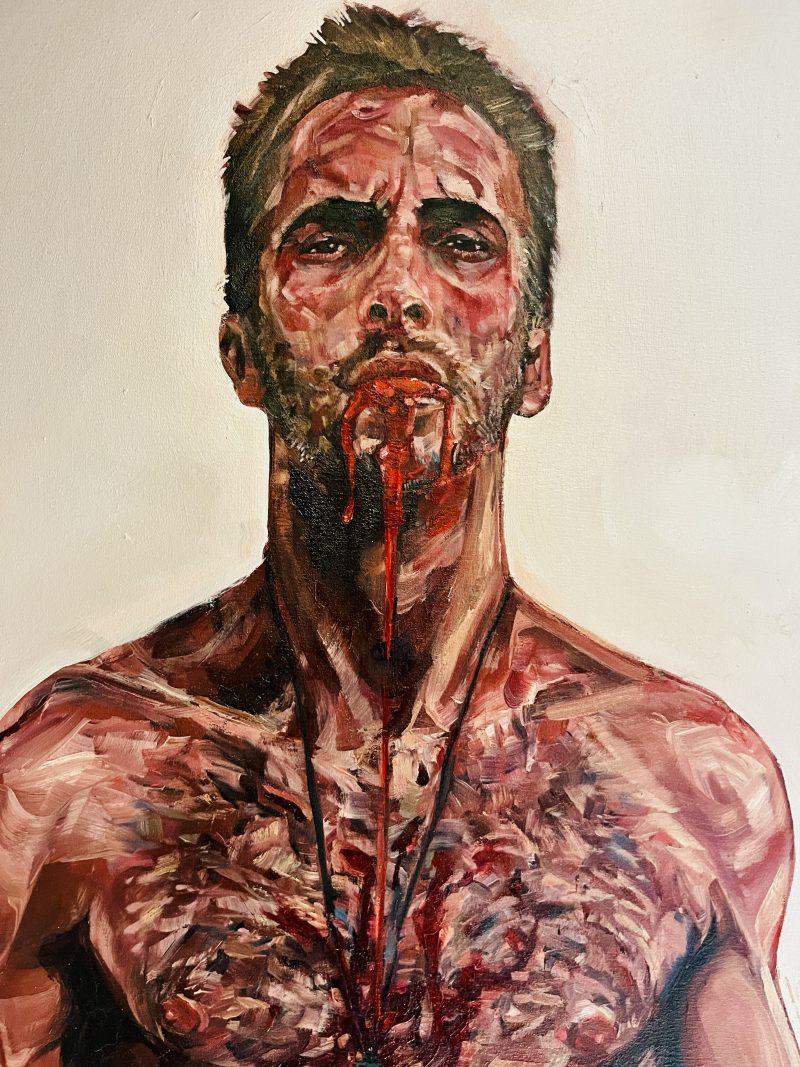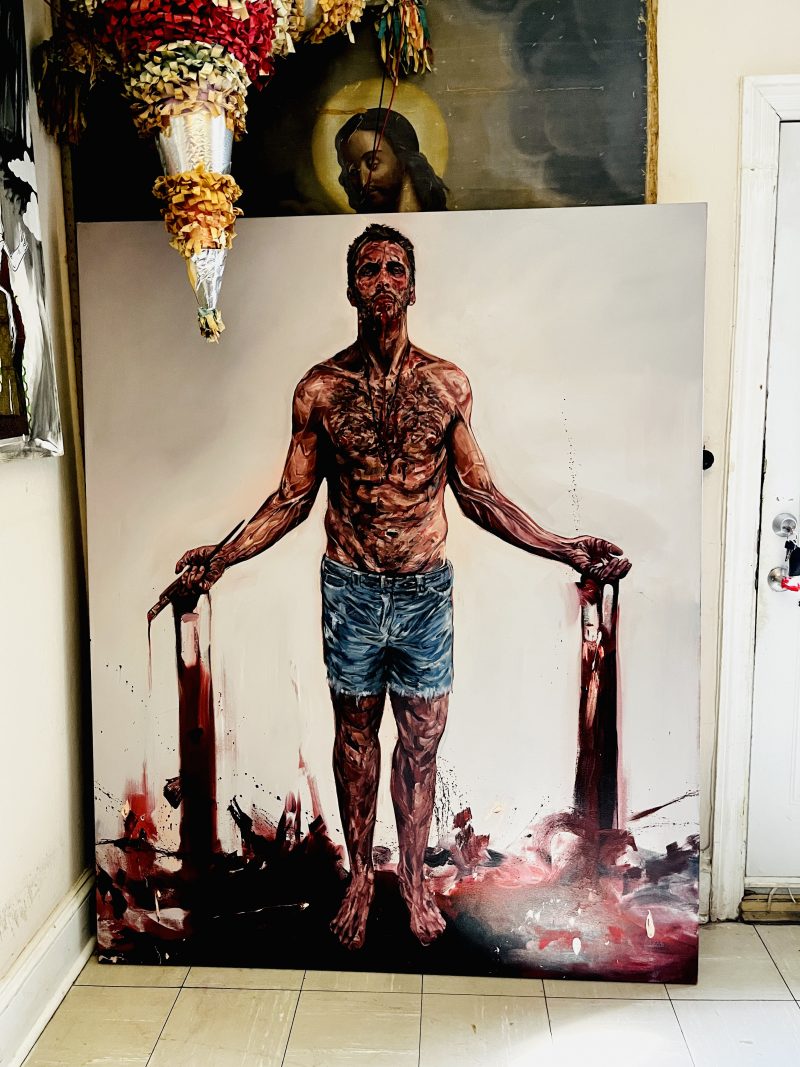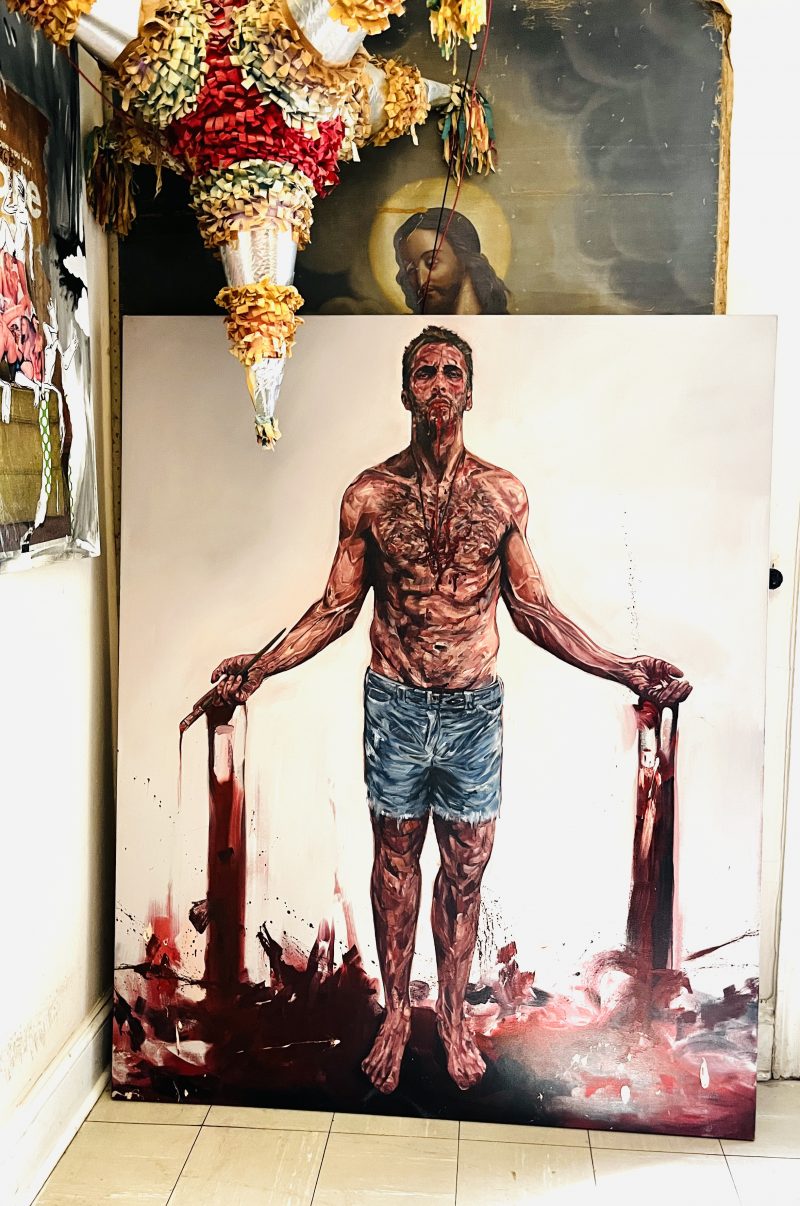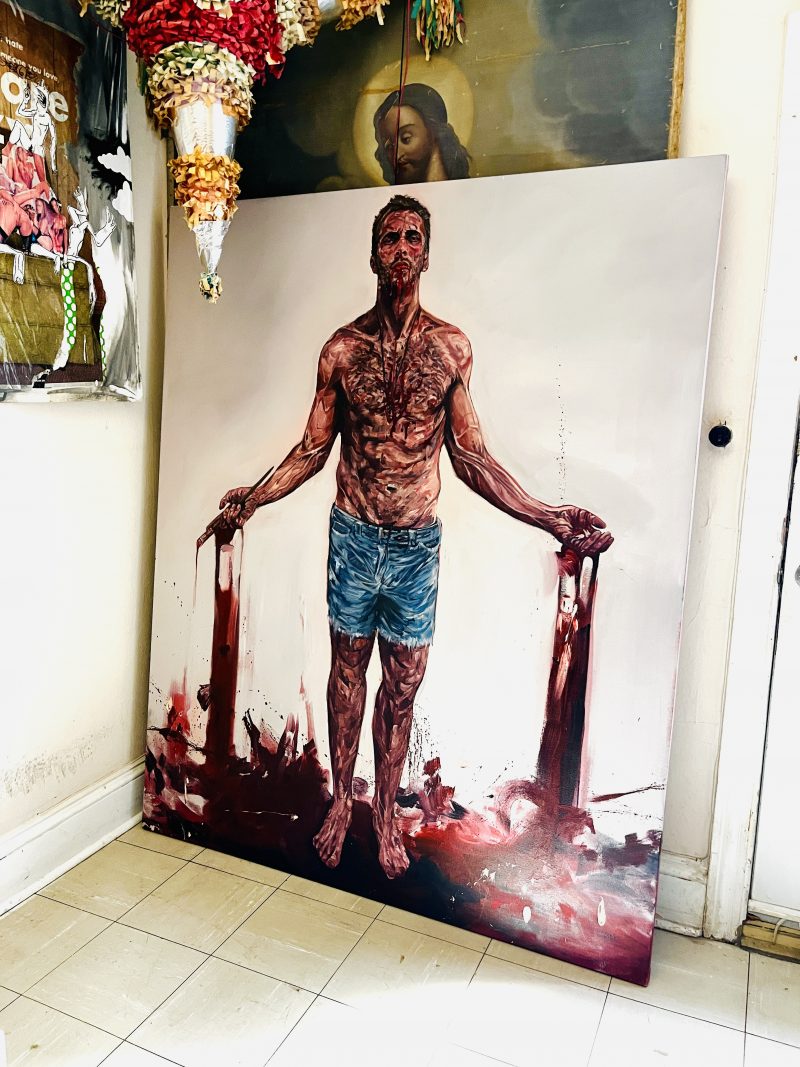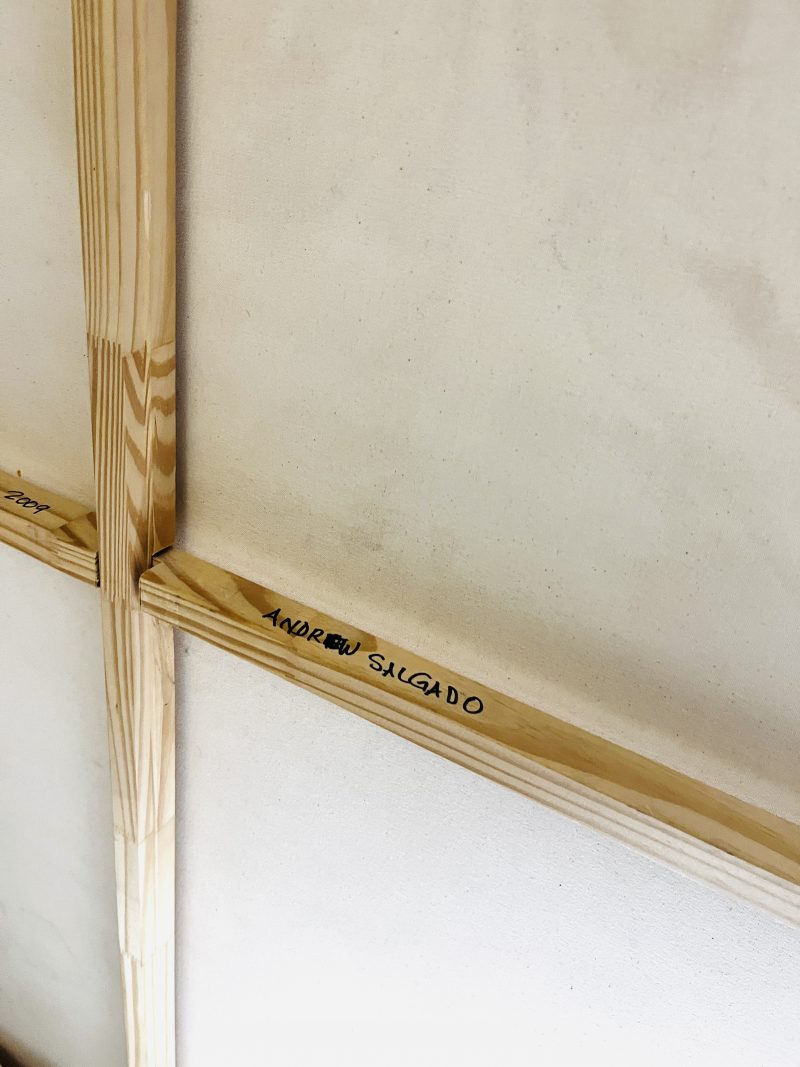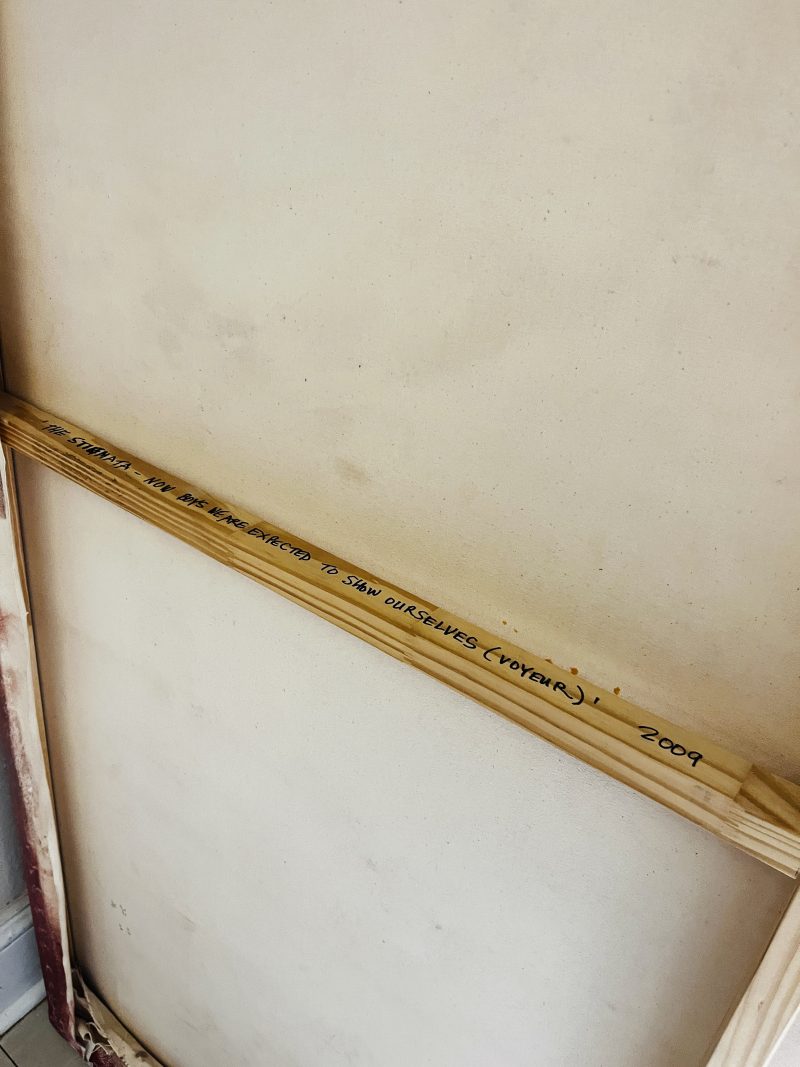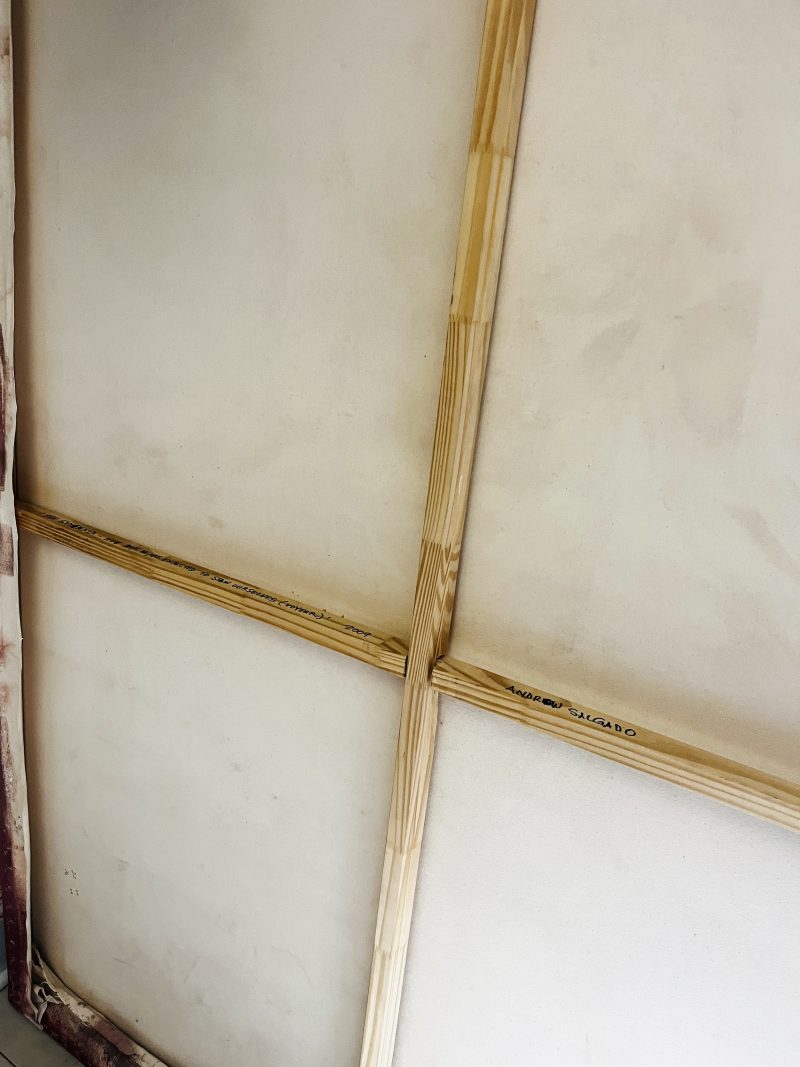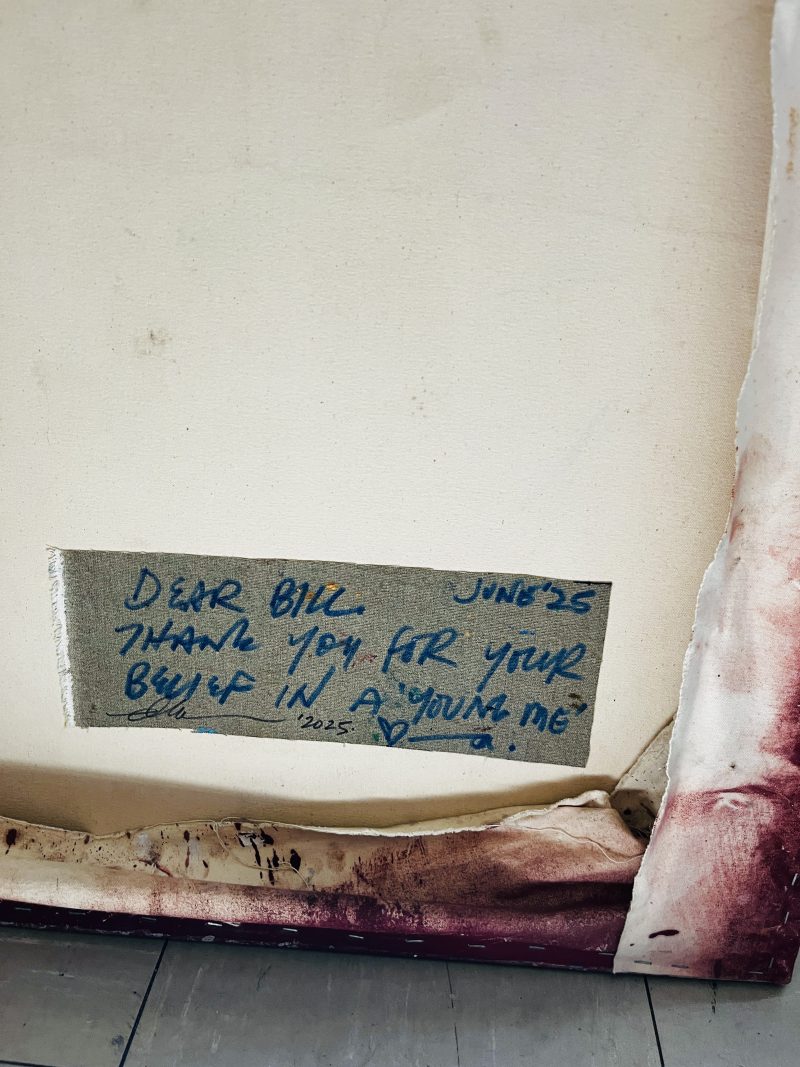Andrew Salgado (London, England) ‘Stigmata’, 2009, Self-Portrait, Oil on Canvas
‘It’s not my art that’s violent,
It’s life that’s violent.’
– Francis Bacon
SOON TO BE OFFERED AT AUCTION at SWANN’S, NEW YORK, Summer 2025.
Andrew Salgado
(b. 1982, Canadian)
‘The Stigmata: Now Boys We are Expected to Show Ourselves (Voyeur)’, 2009
Oil on canvas, 195cm x 155cm
Signed and titled on verso with Certificate of Authentication
Provenance: Beers Contemporary, London, England & La Petite Mort Gallery, Ottawa, Canada
Market Value Appraised by KURT BEERS Gallery, London Gallery:
– KURT BEERS, Director, Beers London, International representation for Salgado.
Canadian curator and art dealer Guy Berube, of La Petite Mort Gallery, Ottawa (2005-2015) presented Salgado’s first solo exhibit at LPM, which successfully sold-out before opening night. Berube also included Salgado in international group exhibitions in Madrid (Spain), Santiago (Chile), Amsterdam (Holland) & Buenos Aires (Argentina), all between 2010 -2015.
For over a decade, Andrew Salgado has led the contemporary figurative vanguard with paintings that defy genre convention or simple categorization. They are playful but emotive; intricate yet planar; symbolic but also direct. Although the figure remains the core aspect of his paintings, his narrative is complex and inviting, and has earned him accolades and a dedicated international following of collectors and admirers.
Salgado’s subjects are depicted in a fantastical, often ominous tableaux, with any combination of patterns and excess play upon the painted surface, including harlequin-like figures, the motif of a heavy, low-hanging moon; or other (un)recognisable representational motifs sift in and out of the composition, partially obscured or partially revealed. There are abundant references to the tradition of figurative painting, both historic and contemporary, but increasingly an affinity for themes relating to literature, nature, and the self. Reinventing himself with every successive body of work, Salgado’s practice is always surprising, technically inventive, and forever unique.
ANDREW SALGADO (b. 1982, Regina, Canada) graduated with an MA in Fine Art from Chelsea College of Art in 2009, and is regarded as one of the United Kingdom’s leading figurative painters. He has exhibited worldwide, with solo exhibitions including London, New York, Tokyo, Miami, Toronto, Cape Town, Sydney, and throughout Europe.
Solo exhibitions include: Tomorrow I’ll Be Perfect, presented by BEERS London, Saatchi Gallery, London (2023); CAN Art Fair, Ibiza, Spain (July 2023); Good Things, Piermarq*, Sydney, Australia (2023); The Lotus Eaters, Maki, Tokyo, Japan (2022); A Never-Setting Sun, BEERS London (2022); Strange Weather, BEERS London (2020); Paperbag Prince, Untitled Art Fair, Miami (2019); Blue Rainbow, Angell Gallery, Toronto, Canada (2018); Dirty Linen/The Nihilist’s Alphabet, Christopher Moller Gallery, Cape Town, SA (2018); A Room with a View of the Ocean, Lauba, Zagreb, Croatia (2017), TEN, Canadian High Commission, London (2016) and; The Snake, BEERS London (2016).
Group exhibitions include: Flowers: Flora in Contemporary Art & Culture, Saatchi Gallery, London (2025); Fierce Form, Art Megastar, Los Angeles (2024); 13-A-Dozen, Galleri Sanberg, Odense, Denmark (2023); Showstopper, Saatchi Gallery, London (2022); Come Out & Play, BEERS London (2022); PINK, Piermarq*, Sydney, Australia (2022); paper. , BEERS London (2022); Paperwork’s Vol. II, NBB Gallery, Berlin, Germany (2021); John Wolf presents … Interconnected, Los Angeles (2021); BEERS London at Zona Maco Art Fair, Mexico City (2019); Berlin Calling, Galerie Kornfeld, Berlin, Germany (2018); Summer Salon, BEERS London (2018) and; The Therapist’s Office, 1969 Gallery, New York (2018).
In 2017, Salgado was the youngest artist ever to receive a survey exhibition at The Canadian High Commission in London. He has received extensive press both online and in print, and he frequently donates to charities and is a frequent advocate for LGBT causes. His works have successfully entered the secondary market with prices frequently doubling their estimates, including a piece at Phillips New York selling for five times its estimate in June 2021.
His works have been collected extensively, including The Oketa Collection, The Royal Bank of Canada Collection, The Masahiro Maki Collection, Government of Canada, The Jordanian Royal Family, Simmons & Simmons, the Esquinazi Collection, Edwin Oostmeier Collection, and more.
He lives and works between London, England and New Brunswick, Canada.
RESEARCH & AUCTION RESULTS:
March 2016, his most recent donation to Terrence Higgins Trust (THT), a painting measuring (71x81cm) went at auction at Christie’s for £16,000 ($23,000USD).
https://old.beerslondon.com/exhibitions/andrew-salgado-the-fool-makes-a-joke-at-midnight/
ANDREW SALGADO
Salgado, the youngest artist to be selected for a retrospective at the Canadian High Commission.

This month, Andrew Salgado will become the youngest artist to be featured by the Canadian High Commission. At just 34 years old, he’s already had 11 sold out shows and has appeared in exhibitions all across the globe. His rapid rise within the art world has been accomplished through his exquisite portraiture, which is formed through a diversity of lines and shapes to create the finished product that unlike anything else making the rounds on the Canadian art scene. With an artistic style that’s hard to pin down (“I wish I knew” he tells us when we ask him to describe is artistic style), it’s his distinctive technique that makes him one of the most innovative voices of contemporary art world.
For his upcoming retrospective, aptly named ‘Ten’, the exhibit will explore the last ten years of Salgado’s work, offering art-lovers the unique opportunity to explore the painters’ creative progression throughout his vibrant career. You can expect to see some of Salgado’s much-discussed work, including ‘Bloody Faggot’ which he birthed as a reaction to being a victim a hate crime and ‘Pretender’ which he created following a friend’s near-death experience. Behind each painting is a unique story, with every collection coming together to create a bigger narrative that viewers can digest and interpret in their own way.
Ahead of the ‘Ten’ opening to the public, we grabbed a moment with Andrew to talk about his career so far.

When did you first get interested in painting?
I was always interested in painting – even as a kid. I was one of those odd, kinda girly, kinda awkward kids that would fake sick for soccer practice but was like, enrolled in pottery classes and making Tiffany lamps at 11 years old. I mean, in the end it worked out for me but I was a private kid. I had a little playroom as a child and would just spend all day drawing and painting and playing with LEGO. I think it makes sense that as an adult, I’m basically doing the same thing. Realistically, it wasn’t until I was in high school that I had a seminal two years with a teacher who pushed me to pursue my art further. Prior to that I had always considered art as a hobby… I mean, I come from a family of academics; you just didn’t go into university for painting…the thought that I might pursue a Fine Arts degree was pretty frowned upon at first. My parents’ friends would ask me what I was taking in university and then there would be this awkward conversational limbo when I had to clarify that I was taking ‘Fine Arts’ and not ‘Finance’. Its just always been the most defining characteristic about me. I’ve often said that without art, I’m nobody. I’m a non-person. Talk about co-dependency!
What does it mean to you to be the youngest artist ever selected by the Canadian High Commission?
It’s a crazy, huge honor to be selected to exhibit there. To be the youngest artist just gives me more resolve. I think as artists, we have a natural tendency to second-guess our purpose and ability. What is the point of it all, that kind of self-doubt. I think its exacerbated for me as well because my working methods are so insular: I lock myself in my studio for 4, 5, 6 months at a time and nobody but my gallerist, my assistant, my partner, and one of my closest friends sees any of the work in progress… So of course there are emotional and psychological ebbs and flows. Sometimes you’re at the peak of the rollacoaster, thinking, okay, I am definitely on to something here, but other days are not as positive. I guess this is a very roundabout way of answering your question by saying that it gives me resolve and confidence that I’m doing something right. I always say I’m not sure if its conviction or stupidity, but I’ve got it in spades. I think as people we often suffer from this idea of ‘imposter syndrome’… you know, what if someone finds out that I’m actually completely uncertain of what I’m doing. I made a painting called “Pretender” in 2014 that sort of addressed that issue. You hear a lot of professionals talk about this – but this survey show, along with the release of my first monograph was perhaps the first time I looked at my assistant and said, oh my god. This is real. I’m a real artist. It’s a funny realisation. The word professional sounds so silly but I guess that’s what I have to call myself now, haha.
Your work sometimes explores you own personal experiences, would you say that you use painting as an emotional outlet?
I was a victim of a hate-related assault in 2008. It anchored my work and painting was my catharsis. It allowed me to convalesce beyond the purely physical scars. There were a series of paintings at the time that dealt directly with that incident, I was finally able to close the door with a second version of a piece called “Bloody Faggot” (2011). In fact, it was the only piece that I insisted the curator include in the survey exhibition for the High Commission show. I’ve always used it as such. I get antsy if I have to be away from my studio for too long.
Tell us about where your inspiration comes from.
As a younger artist I used to think inspiration had to come from some divine fount. Like, everything had to be big, operatic, melodramatic. As I mature, inspiration comes from smaller, more intimate sources. Sometimes it’s a conversation; a song; a poem; a memory; or even silly things…I did a painting called “Oh!” Which was inspired by a kid’s paper party hat that I found in my studio. My exhibition “The Fool Makes a Joke at Midnight” was inspired by the death of David Bowie and the resulting painting was called “Sound & Vision”. Sometimes the subject provides inspiration…my favourite subject is painter Sandro Kopp, who is also Tilda Swinton’s partner. I don’t like the word ‘muse’ because I think its overused, but he, along with model and friend Anna Cleveland, were the original sources of inspiration for my show “The Snake”. That eventually evolved into something much bigger…the show discussed homophobia, Islamophobia, xenophobia, and I even painted my first transgender subject in “Chrysalis (Portrait of a Girl)”. Little things can become bigger things, but “The Snake” took me to darker places that I was fully prepared to go. Lately, installation has been integral to the reading of the work. The paintings are stretching their limbs beyond their own confines. I just want to let them breathe, and take me on a journey that is more irreverent. I don’t want to be so political right now. The world is ugly enough, I want to have fun and make people smile. For my next show, I’m keeping my head above the water. I’ve asked Australian artist Rhys Lee to make sculptures to accompany my paintings, and we’re doing a show called “A Room With A View of the Ocean”. My assistant is currently sourcing lemon yellow furniture…if that tells you anything. Right now I’m inspired by freedom. Possibility. The idea of an endless horizon. That gives me room to experiment.
“As a younger artist I used to think inspiration had to come from some divine fount. Like, everything had to be big, operatic, melodramatic. As I mature, inspiration comes from smaller, more intimate sources”
In your opinion, what is your best/favourite work and why?
I mean, this is really a trick question. Its Sophie’s Choice, isn’t it? I love them all, for different reasons. From the last show, “Echo Chamber” speaks to me. But I’ve said that “Afterlife” was the soul of the show. “The Dancing Serpent” was the heart. “Orlando” was an important piece. I mean, if they don’t have something, they don’t leave the studio. Sometimes they get torn apart in really dramatic gestures. Then lately I’ve been stitching these bits back into other works like some artistic version of Ed Gein. That’s kind of an unsavoury analogy, isn’t it?
Tell us about the creative process around each work.
I’m very fortunate that I have a massive studio, so I compare my creative process to a bathtub filling up, as opposed to stacking building blocks. One painting informs the next, and vice versa, and then back again, like an Orouboros. I typically take 6 months to complete a body of work, which can be as few as 9, or as many as 18 paintings…the narrative tells me when its complete. That sounds so artsy-fartsy but it’s the truth. Its like a conversation, a dance. I have to be flexible to the paintings and their needs.
I chose people that speak to me somehow. We don’t know each other going in, but when we come out, we typically have a strange bond. I had to pursue Caz, my subject for “Afterlife” for a number of months. I think he thought I was crazy or something, but eventually I got him in, and now we have this strange bond. He’s a wonderful man, we’re connected. Its something operating on a deeper level because in all reality I prefer to paint people that I don’t know. I work from photo, and I tell the subjects to wear whatever they want and to be themselves…sometimes the surprises that they bring into the studio with them – an earring, a shirt, an attitude – ends up being the defining characteristic of the piece.
A lot of your paintings focus on male portraiture, what is it that interests you about the male physical form?
You know the saying paint what you know? Well I’m a young white dude, so I often end up painting young white dudes. Though my ‘type’ is changing drastically. I’m also gay, but I don’t paint the proverbial ‘object of my affection’. But another artist once said it really eloquently: that as an artist we have to assume the identity of our sitter, and its harder for me to assume the role of a female. I can connect to a man better.
What are you hoping to achieve long-term in your art career?
Everything.


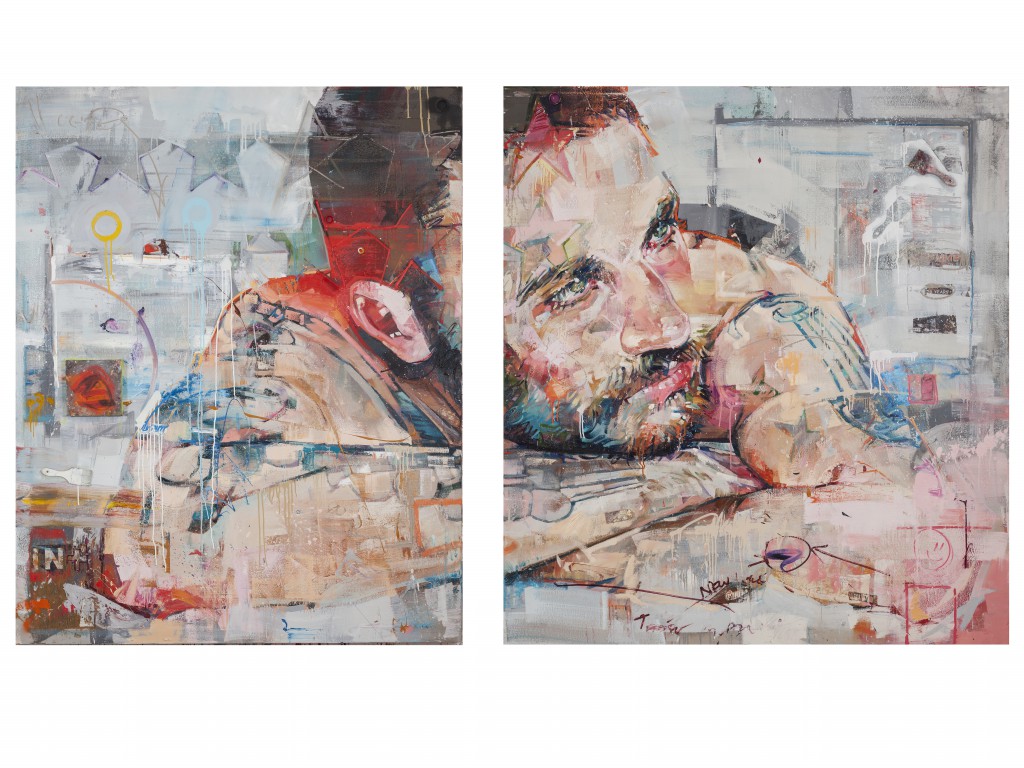

MORE PRESS:
Andrew Salgado: Portrait of the Artist as a Young Man on the Rise
A detail from Salgado’s Trust, 2012.
‘Portrait of the Artist as a Bloody Man’
Andrew Salgado’s new solo show
STARK CONTRAST. Andrew Salgado is bright-eyed and effervescent but his self-portrait recalls a darker time when he was bashed.Credit: Tony Correia photo
Sitting in his tiny studio inside the Dominion Building, Andrew Salgado is bright-eyed and effervescent, his dog Zoe at his feet, the kind of guy you would want to introduce to your parents.
“That’s you?” I ask. He nods, smiling.
The portrait, which is plastered around town on street posts and club cards, is a stark contrast to the 25-year-old sitting across from me. In it, he is wiping blood away from his sweat-smeared face like a boxer between rounds. It’s erotic in a pugilistic way. Then he tells me what inspired it.
Salgado was with his boyfriend and a female friend when someone called him a faggot. “I’ve been called that before but something in me said, ‘You just don’t call me this’ and it was a matter of do I turn around and walk away or do I stick up for myself? And I stuck up for myself and I lost my teeth because of it. And then I was arrested because of it.”
The portrait is based on the photos his boyfriend took after the incident. No charges were ever pressed against Salgado, his boyfriend or the eight guys that attacked them.
“Everybody is so smart afterwards saying, ‘You should have done this or you should have done that’ and you say, ‘You know what? The bottom line is there’s no excuse for it.’ I can’t say it won’t happen again because there are people out there who just don’t like people for whatever reason.”
Salgado credits moving to Vancouver from Regina for helping him come to terms with his sexuality and becoming more confident as a person and an artist. Growing up in the Prairies he shied away from his sexuality for fear of upsetting his parents. Looking back on his gay adolescence he says he was using his parents as an excuse to hide his own doubts and fears.
Last month’s exhibit at the Interurban Gallery showcased Salgado’s work, from acrylics to his bolder oil canvases. He describes his work with acrylics as being rigid, studied and regimented whereas the oils are explosive and raw.
“I was done before I knew it,” he says of the self-portrait. “I don’t want to say art is my therapy, but it is a way of dealing with things.”
Salgado describes his solo show as a grassroots movement, something that would not have happened without the efforts of his friends. Most of them are featured in his art, based on photos Salgado has digitally enhanced.
Not only do his friends encourage and support him, they are walking the canvasses through the crowded Downtown Eastside by hand as we speak.
Cameron Scott, his friend from university, is impressed with Salgado’s ability to capture the essence of a person. He points to the bloodiest in the series of three paintings on violence. The subject is their friend after he had been mugged and hit in the face with a bottle.
“He’s always this happy smiley-face kind of guy, so you’ve got his happy smiling face with a big bulbous eye and a bandage on it.”
Salgado’s boyfriend explains that the big bulbous eye and Salgado’s self-portrait are bookends, that the three paintings form an arc. I ask if he could ever separate himself from the self-portrait, if it offered some sort of closure. Although they did grow individually and as a couple as a result of the attack, “that feeling of seeing Salgado with his teeth out and blood gushing and us both being arrested and hauled away and separated from each other and not allowed to be together at that moment when all we wanted was to console each other — it was horrific,” he replies.
John Lowen, with whom Salgado did his BFA, feels the move from acrylics to oils speaks to Salgado’s confidence as a painter. “The acrylics are more graphic in nature,” he says. “Closer to illustration. Whereas oil becomes a one-on-one relationship; your paintbrush explains the subject.”
After the exhibit, Salgado plans to do his Masters at Chelsea College of Art and Design. He feels that, even with the bashing, he’s been pretty fortunate.
I ask him what kind of impact he thinks the proposed Conservative budget cuts to the arts will have on queer culture.
“Artists are marginalized to a certain extent,” he says. “Queers are marginalized to a certain extent. Queer artist is just compounding it.
“It’s hard enough to get grants in this day and age. To keep slashing and cutting, it just means there’s going to be less and less people willing to take a chance and say, ‘I’m talented maybe I should pursue that and maybe I shouldn’t do my ‘safe’ degree, because that’s what I really want to do.’”
EDUCATION
2009 Master of Fine Art (Hons). Chelsea College of Art. London, England. (Distinction).
2005 Bachelor of Art, Art History & Theory. University of British Columbia. Vancouver, Canada.
AWARDS
2019 1606 Paintguide Residency, The Plant. (Leiden, Holland).
2015 PULSE prize. Pulse Miami Beach. [Shortlisted]2013 Lieutenant Governor’s Arts Award. Saskatchewan, Canada.
2013 Canada Council for the Arts. Independent Artist Production Grant.
2013 Saskatchewan Arts Board. Visual Artist Production Grant.
CURATION & WRITING
2023 Studio Lencas, Flower Boys text, Edji Gallery, Brussels (Belgium)
2023 While You Were Sleeping, Hyangmok Baik solo text The Gasoline Pump Is Not A Toy, Beers London (London)
2022 Come Out & Play, Beers London (London)
2021 Future Fairs Christmas Market
2016 Guest Curator for Fresh Paint Magazine. Edition 12.
2016 Juror for Anthology. Charlie Smith London.
2015 The Fantasy of Representation. Beers London, UK. (August)
PUBLICATIONS
2017 TEN. Artist monograph.
2014 100 Painters of Tomorrow. Thames & Hudson. London, UK.
COLLECTIONS
Andrew’s work has been placed in numerous public and private collections internationally, including:
The Oketa Collection, Tokyo, Japan
The Royal Bank of Canada
The Masahiro Collection
The Jordanian Royal Family
The Government of Canada
The Saskatchewan Arts Board
Standard Chartered Bank
Simmons & Simmons Collection
The Dewitt-Barlow Collection
Markit Collection
The Esquinazi Collection
Victor Benady Collection
Nick Cave Collection
Mario Garcia Collection
Yi Xiao Collection
Woo Meng Collection
Steffen Heinze Collection
Weissman Collection
CHARITABLE WORK
Andrew frequently donates to a number of charities;
most notably The Terrence Higgins Trust (UK) where his works have raised
over £135,000 since 2014.
ART FAIRS
2023 Contemporary Art Now (CAN), Ibiza, Spain, Beers London (July)
2020 Art Toronto, Toronto, (online). Beers London (October-November)
2019 Untitled Art Fair Miami Florida, (w/ Sebastian Neeb). Beers London (December)
2019 Zona Maco, Mexico City, (various artists). Beers London (February)
2018 Cape Town Art Fair, (solo). Christopher Moller Gallery (January)
2015 Pulse, Miami Florida, (solo). Beers London (December)
2015 Volta, Basel (solo). Beers London (June)
2015 Art15, London (various artists). Beers London (May)
2015 London Art Fair (various artists). Beers London (January)
2014 Art14, London (various artists). Beers London (March)
2014 London Art Fair (various artists). Beers London (January)
2013 Toronto International Art Fair (w/ Robert Fry). Beers London (October)
SOLO EXHIBITIONS
2023 Tomorrow I’ll Be Perfect, SAATCHI Gallery, London (November)
2023 Good Things, PIERMARQ* Gallery, Sydney (April)
2022 The Lotus Eaters. MAKI Gallery, Tokyo, Japan (Oct.-Nov)
2022 A Never-Setting Sun. BEERS London, (April)
2020 Strange Weather. Beers London (October)
2018 Blue Rainbow. Angell Gallery, Toronto, Canada (October)
2018 Dirty Linen/The Nihilist’s Alphabet. Christopher Moller Gallery, Cape Town, SA (February)
2017 A Room with A View of the Ocean. Lauba, Zagreb, Croatia (April)
2016 TEN. Canadian High Commission. Trafalgar Sq, London (December).
2016 The Snake. Beers London (November)
2016 The Fool Makes a Joke at Midnight. Thierry Goldberg, New York (May)
2015 A Quiet Man. Beers London at PULSE Miami Beach. Miami, FL (December)
2015 This is Not the Way to Disneyland. VOLTA Basel. Basel, Switzerland (June)
2014 Storytelling. Beers London (October)
2014 Variations on a Theme. One Art Space. New York, NY (May)
2014 Enjoy the Silence. Christopher Møller. Cape Town, South Africa (January)
2013 The Acquaintance. The Art Gallery of Regina. Regina, Canada (October)
GROUP EXHIBITIONS
2023 13-A-Dozen, Galleri Sanberg, Odense, Denmark (May)
2022 Showstopper, Saatchi Gallery, London (September)
2022 Come Out & Play, Beers London, London (June)
2022 PINK, Piermarq* Gallery, Sydney (April)
2022 Paper! Beers London, London (January)
2021 Paperworks Vol. II, NBB Gallery, Germany (December)
2021 John Wolf presents… Interconnected. Los Angeles, CA (October)
2018 Berlin Calling. Galerie Kornfeld, Berlin, Germany (September)
2018 Summer Salon. Beers London (June, July)
2018 The Therapist’s Office. 1969 Gallery. New York, NY (April)
2018 Secret Gay Box. Curated by John Wolf. Spring Break Art Fair. New York (March)
2017 75 Works on Paper. Beers London (November)
2017 O Canada. Beers London (June)
2016 35 Works on Paper. Beers London (September)
2016 Rema Hort Mann Charity Exhibition. Hort Family Gallery. New York (May)
2015 The Fantasy of Representation (curated by Andrew Salgado). Beers London (March)
Stigmata (Ancient Greek: στίγματα, plural of στίγμα stigma, ‘mark, spot, brand’), in Catholicism, are bodily wounds, scars and pain which appear in locations corresponding to the crucifixion wounds of Jesus Christ: the hands, wrists, feet, near the heart, the head (from the crown of thorns), and back (from carrying the cross and scourging).
St. Francis of Assisi is widely considered the first recorded stigmatic. For over fifty years, St. Padre Pio of Pietrelcina of the Order of Friars Minor Capuchin reported stigmata which were studied by several 20th-century physicians. Stigmatics are primarily a Roman Catholic phenomenon; the Eastern Orthodox Church professes no official view on them.
A high percentage (probably over 80%) of all stigmatics are women. In his book Stigmata: A Medieval Phenomenon in a Modern Age, Ted Harrison suggests that there is no single mechanism whereby the marks of stigmata were produced. What is important is that the marks are recognised by others as of religious significance. Most cases of stigmata have been the result of trickery. Some cases have also included reportings of a mysterious chalice in visions being given to stigmatics to drink from or the feeling of a sharp sword being driven into one’s chest.
Description

An individual bearing the wounds of stigmata is a stigmatistor a stigmatic. In Galatians 6:17, Saint Paul says:
Τοῦ λοιποῦ κόπους μοι μηδεὶς παρεχέτω· ἐγὼ γὰρ τὰ στίγματα τοῦ Ἰησοῦ ἐν τῷ σώματί μου βαστάζω.
From henceforth let no man trouble me: for I bear in my body the marks of the Lord Jesus.
A stígma (στίγμα) is a mark on the skin.
Reported cases of stigmata take various forms. Many show some or all Five Sacred Wounds that were, according to the Bible, inflicted on Jesus during his crucifixion: wounds in the wrists and feet, from nails; and in the side, from a lance. Some stigmatics display wounds to the forehead similar to those caused by the crown of thorns. Stigmata as crown of thorns appearing in the 20th century, e.g. on Marie Rose Ferron, have been repeatedly photographed. Other reported forms include tears of blood or sweating blood, and wounds to the back as from scourging.
Many stigmata show recurring bleeding that stops and then starts, at times after receiving Holy Communion; a significant proportion of stigmatics have shown a strong desire to receive Holy Communion frequently. A relatively high percentage of stigmatics also exhibit inedia, claiming to live with minimal (or no) food or water for long periods of time, except for the Holy Eucharist. Some exhibit weight loss, and closer investigation often reveals evidence of fakery.
Some stigmatics claim to feel the pain of wounds with no external marks; these are referred to as “invisible stigmata”. Some stigmatics’ wounds do not appear to clot, and seem to stay fresh and uninfected. The blood from the wounds is said, in some cases, to have a pleasant, perfumed odor, known as the Odour of Sanctity.
Individuals who have obtained the stigmata are many times described as ecstatics, overwhelmed with emotions upon receiving the stigmata.
In his paper Hospitality and Pain, Christian theologian Ivan Illich states: “Compassion with Christ … is faith so strong and so deeply incarnate that it leads to the individual embodiment of the contemplated pain.” His thesis is that stigmata result from exceptional poignancy of religious faith and desire to associate oneself with the suffering Messiah.
Differently from the Five Holy Wounds of Christ, some mystics like Francis of Assisi and father Pio of Petralcina reported a spontaneous regression and closure of their stigmata in the days following their death. Both of them claimed to have received the divine stigmata in their hands as well as in their feet.
Specific cases
Saint Ansbert of Rouen
Earlier reports of stigmatics do exist, however there is a lack of consensus on how the concept of stigmata was understood pre-Saint Francis. St. Ansbert of Rouen (d. 695 AD) could be considered the earliest stigmatic due to the claims of witnesses following his death:
“When they had opened his tomb and they thought his body would stink because of the amount of time that had elapsed since it had been buried, such a sweet fragrant odor like a diversity of flowers flowed forth, and the whole church was filled with little drops of balsam. And when the brothers who had come to see him from the neighboring province… removed the clothes in which he had been buried because they wanted to change them wishing to dress him in new clothes, they found on his forearms the sign of the dominical cross, bearing the likeness of a red color. It was evident to all the faithful that this was given to be understood that while he lived he bore the arms of Christ in his heart, therefore, Christ’s stigmata were revealed on the body of the dead man.”[18]
Saint Francis of Assisi


St. Francis of Assisi is widely considered the first recorded stigmatic in Christian history.[19] In 1224,[20] two years before his death, he embarked on a journey to Mount La Verna for a forty-day fast. The legend states that one morning, near the feast of the Exaltation of the Cross, a six-winged angel appeared to Francis while he prayed. As the angel approached, Francis could see that the angel was crucified. He was humbled by the sight, and his heart was filled with elation joined by pain and suffering. When the angel departed, Francis was left with wounds in his hands, feet, and side as if caused by the same lance that pierced Christ’s side. The image of nails immediately appeared in his hands and feet, and the wound in his side often seeped blood. Pope Alexander IV and other witnesses declared that they had seen these marks both before and after his death. In traditional artistic depictions of the incident, Francis is accompanied by a Franciscan brother.
St. Francis’ first biographer, Thomas of Celano, reports the event in his 1230 First Life of St. Francis:
When the blessed servant of God saw these things he was filled with wonder, but he did not know what the vision meant. He rejoiced greatly in the benign and gracious expression with which he saw himself regarded by the seraph, whose beauty was indescribable; yet he was alarmed by the fact that the seraph was affixed to the cross and was suffering terribly. Thus Francis rose, one might say, sad and happy, joy and grief alternating in him. He wondered anxiously what this vision could mean, and his soul was uneasy as it searched for understanding. And as his understanding sought in vain for an explanation and his heart was filled with perplexity at the great novelty of this vision, the marks of nails began to appear in his hands and feet, just as he had seen them slightly earlier in the crucified man above him.
His wrists and feet seemed to be pierced by nails, with the heads of the nails appearing on his wrists and on the upper sides of his feet, the points appearing on the other side. The marks were round on the palm of each hand but elongated on the other side, and small pieces of flesh jutting out from the rest took on the appearance of the nail-ends, bent and driven back. In the same way the marks of nails were impressed on his feet and projected beyond the rest of the flesh. Moreover, his right side had a large wound as if it had been pierced with a spear, and it often bled so that his tunic and trousers were soaked with his sacred blood.
From the records of St. Francis’ physical ailments and symptoms, Edward Frederick Hartung concluded in 1935 that he knew what health problems plagued St. Francis. Hartung believed that he had an eye ailment known as trachoma and quartan malaria.
Quartan malaria infects the liver, spleen, and stomach, causing the victim intense pain. One complication of quartan malaria occasionally seen around Francis’ time is known as purpura, a purple hemorrhage of blood into the skin. According to Hartung “If this were the case of St. Francis, he would have been afflicted by ecchymoses, an exceedingly large purpura. The purple spots of blood may have been punctured while in the wilderness and there appear as an open wound like that of Christ.”
A later medical hypothesis was proposed in 1987 to explain the wounds, it claimed that St. Francis may have contracted leprosy.
Saint Padre Pio of Pietrelcina

For over fifty years, Padre Pio of Pietrelcina reported stigmata which were studied by several 20th-century physicians, whose independence from the Church is not known. The observations were reportedly inexplicable and the wounds never became infected. His wounds healed once, but reappeared. The wounds were examined by Luigi Romanelli, chief physician of the City Hospital of Barletta, for about one year. The physician Angelo Maria Merla noted that the wounds were not tubercular in origin but could not make an official diagnosis without further tests. The surgeon Giorgio Festa, a private practitioner, also examined them in 1920 and 1925. Professor Giuseppe Bastianelli, physician to Pope Benedict XV, examined the wounds, but no report of his examinations was made. Pathologist Amico Bignami of the University of Rome also observed the wounds, describing them as shallow. Festa, who had originally agreed with Bignami, later described the wounds as superficial when covered with a scab. Giorgio Festa noted that “at the edges of the lesions, the skin is perfectly normal and does not show any sign of edema, of penetration, or of redness, even when examined with a good magnifying glass”. Alberto Caserta took X-raysof the hands in 1954 and found no abnormality in the bone structure. Giuseppe Sala who worked as a physician for Pio between 1956 and 1968 commented that tests revealed his blood had no signs of abnormality.
There were both religious and non-religious critics who accused Padre Pio of faking his stigmata, saying he used carbolic acid to make the wounds. The historian Sergio Luzzatto recounted that in 1919, Maria De Vito (the cousin of the local pharmacist Valentini Vista at Foggia) testified that the young Pio bought carbolic acid and the great quantity of four grams of veratrine “without presenting any medical prescription whatsoever”. Pio maintained that the carbolic acid was used to sterilize syringes used for medical treatments and that after being subjected to a practical joke where veratrine was mixed with snuff tobacco, causing uncontrollable sneezing after ingestion, he decided to acquire his own quantity of the substance in order to play the same joke on his confreres.
Amico Bignami in a report wrote that the wounds were caused by “neurotic necrosis“. He suggested they had been inflicted unconsciously by suggestion and artificially maintained by iodine that Pio had used as a disinfectant. In 1922, physician Agostino Gemelli went to visit Padre Pio, but Gemelli was denied the right to examine the stigmata without an authorization from the Holy Office. Gemelli irritated and offended for not being allowed to examine the stigmata, wrote that Pio was a hysteric and his stigmata were self-induced, not of supernatural origin. Gemelli also speculated that his wounds were kept open with carbolic acid.Giorgio Festa, who examined the stigmata of the friar on October 28, 1919, wrote in his report that they “are not the product of a trauma of external origin, nor are they due to the application of potently irritating chemicals”.
Throughout his life, Pio had hidden his wounds by wearing fingerless gloves. At death there were no wounds, only “unblemished skin”.
Mariam Thresia Chiramel
The first saint from India with stigmata was nun Mariam Thresia Chiramel.She was canonised on 13 October 2019 by Pope Francis.
Stigmata and gender

In the late nineteenth century, a French physician named Dr. An Imbert-Goubeyre began compiling a census of known stigmatics from the thirteenth century to his own time. This census includes 280 female and 41 male stigmatics, meaning women comprise a little over 87% of the list. Additionally, the University of Antwerp released a database of information on 244 stigmatics in April 2019. 92% of the stigmatics in the database are female. In some cases, convent sisters have attempted to shield stigmatic women from public scrutiny, often out of fear of how their condition would affect the convent’s reputation. So, the number of women stigmatics may be even higher than historical record shows.


